#and i really like all the ways you create that distinct visual contrast between them
Text
What Is Webcomics?
The obvious answer is “comics on the internet”, but...
Sooooo... like this?

...No, not like that.
When some comics are distributed via the internet, we call them “digital” comics, but others are “webcomics”. Even if we aren’t sure how to explain the distinction, we can tell the difference!
And this is despite the fact that some of the creators of successful long-running webcomics, like Ryan North and Chris Hastings, have moved very successfully into the world of comic books, and at least one creator of a popular long-running webcomic (Phil Foglio) came from that world, without this ever really blurring that line. So we can conclude that the difference isn’t just in who makes them
Webcomics Is Free
An obvious difference is in the business model. There are comics that fall on the “digital” side of that imaginary line that use a “pay what you choose” type of model, but generally there is some expectation that each member of the audience pay for the content directly
Contrariwise, the usual business model of webcomics is for the content itself to be available free, while the artist is supported by ad revenue, or by selling merch, or by the generosity of fans.

In many ways, it’s similar to the distinction between movies and television
Webcomics Is Crude
Another common distinction between webcomics and comics that happen to be on the web is an obsession going back to the early roots of the form with using shortcuts to allow a visual story to be told without, in many cases, much in the way of drawing ability. This ranges from pixel sprites, to clip art, to stick figures.
Previously mentioned webcomic superstar, Ryan North, took this tendency to the formalist limit by creating a single page of simplistic pixel art for his Dinosaur Comics and then, for going-on 20 years and 4000 pages, only changing the words every day. Below is my favorite page of Dinosaur Comics, but they’re all the same. Except for having different words.
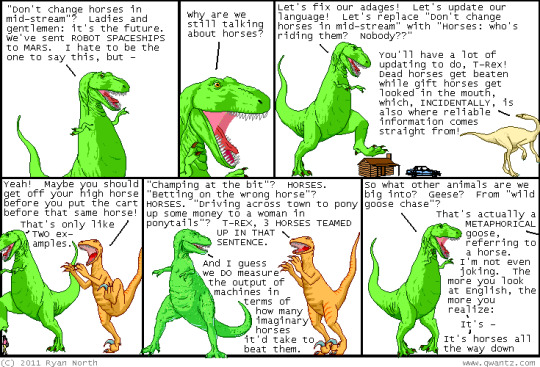
(When I was thinking about this tendency of webcomics, it reminded me of a comic I loved back in the early 2000s, that I was going to describe as a “webcomic except in print”. But upon further investigation, I discovered that Get Your War On had been a webcomic all along, just one that happened to also be printed in a few US cities’ leftist newspapers. Below is an early one, probably the first that I saw, and a perfect representation of why it was such a vital outlet for those few of us not caught up in the war fever in those dark Bush years...)
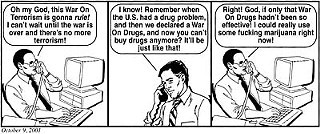
Even those webcartoonists not trying to avoid drawing don’t necessarily have the patience to actually learn to draw before beginning to publish. Webcomics are well known for sometimes stark evolution in their art, and possibly none moreso than my personal favorite webcomic, El Goonish Shive:
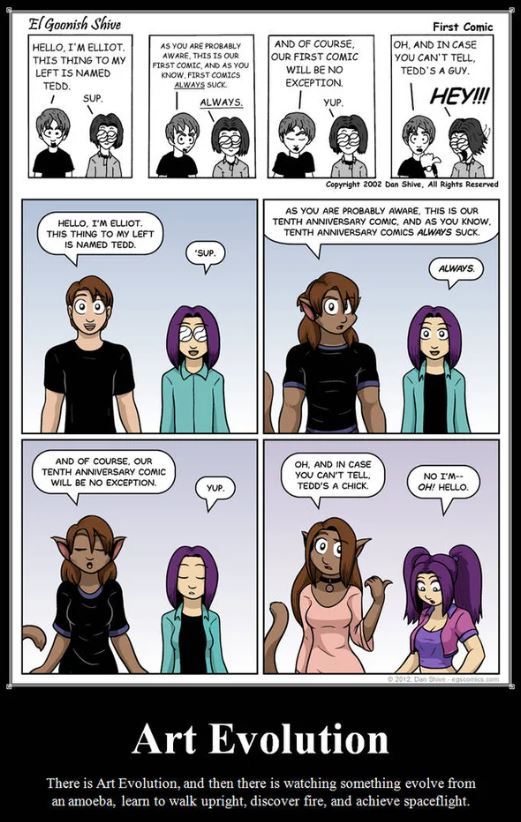
There are definitely major exceptions to this tendency. Many webcomics are gorgeously, lushly illustrated (even from the beginning.) Below is half of a particularly lovely page of a webcomic ode to transhumanism titled Dresden Codak:
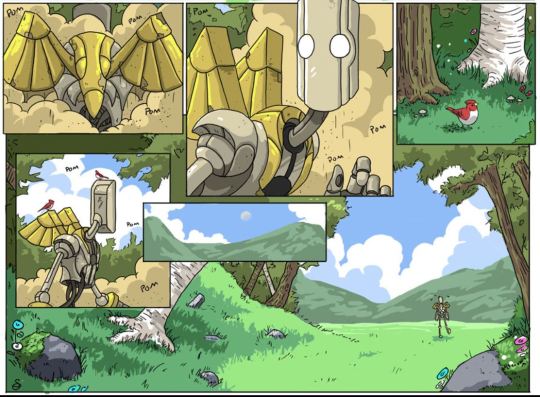
The thing that ties these disparate works together, from those with art that’s crudely sketched, to cleverly sidestepped, to beautifully fully realized, is each has a singular creative vision. In stark contrast with their big bro the comic books, webcomics are distinguished by relatively little collaboration and practically zero editorial meddling. These are the works of passionate amateurs who (sometimes) gradually found ways to make a livelihood from their passion
Webcomics Is Bite-Sized
But beyond the business side of it, and even the low entry barriers and amateurist zeal, the thing that really sets webcomics apart from the comic books to the point of seeming almost a different medium and linking them more closely to even-older sibling the newspaper comics, is the different pacing and structure caused by being released in tiny, tiny chunks
But that’s enough for now, we can talk about the impact on the form of coming out in bite-size installments.... next time!
#webcomics#christopher hastings#ryan north#dinosaur comics#get your war on#david rees#dan shive#el goonish shive#8-bit theater#oots#gitp#rich burlew#girl genius#phil foglio#original content#oc#longform
79 notes
·
View notes
Text
Fall of Porcupine

Rite & Blouse
Fall of Porcupine is a narrative game set in the small town of Porcupine, in which you follow Finley, a young doctor just out of medical school, as he tries to make ends meet between his professional and private lives. The game clearly seeks to denounce the health system and the difficult working conditions of medical staff, but doesn't always follow through on its ideas, in my opinion.
❤ The art direction is really charming, it's colorful and soft on the eyes, the animations are well done and the anthropomorphic characters look really cute and are all very distinct from each other.
❤ Still speaking of the characters, I found them all interesting and even really touching for some of them. You can really build up a deep relationship just by chatting to them a little every day, like a comfortable routine. The dialogues are also very human, with some characters being very direct and others much more philosophical, but their words always ring true.
❤ The visual details that enrich the narrative without having to explain everything, such as Finley's room getting messier and messier, his face getting more tired/depressed as time goes by, the town coming alive and emptying according to the circumstances etc….
+/- So let's get down to the nitty-gritty: the script. In itself, the story is pretty good, and the underlying message about the hospital situation is well conveyed. There are some good ideas, such as creating a real contrast between the calm and soothing life when you're in the city and the cold and stressful side when you enter the hospital, or making the mini-games a little more difficult depending on the pressure you're under in the hostpital ward. The game's creators also consulted real doctors to get as close as possible to their feelings and daily lives, so the situations seem plausible… but the pace of the story is too inconsistent. In fact, the game aims to evoke a certain melancholy feeling by setting a very slow pace for the first few hours, but then suddenly takes off with a series of much more eventful phases, culminating in an extremely abrupt ending. As a result, you get the impression that everything has happened at the end, and that we're barely touching on the problems of the healthcare system, which is the main subject of the game. The finale is certainly open-minded, but doesn't offer any thoughts on potential solutions to improve hospital life, or even address the direct consequences this may have on the town of Porcupine…
+/- The mini-games are fairly varied and enjoyable, but oh my god, some of them are just unplayable with the controller; including a game where you have to keep pressing down on buttons at the same time and I'm asked to twist my fingers into inhuman positions, or a rhythm game where no matter how hard I press the right button, it still counts wrong… it was very frustrating.
+/- The game's music is really very beautiful and helps to create a calm, melancholy atmosphere, but there are a lot of empty moments and not much in the way of other sound effects.
✖ The city isn't that big, but it's divided into 2 areas that take quite a long time to cross on foot. As a result, if you're like me and want to wander around every day to have your little routine conversations with the locals, going back and forth becomes tiring, and you would have needed a shortcut between these two districts.
✖ Quite a few bugs like dialogue bubbles that stick out of the frame, symbols that indicate an interaction but nothing happens when you click on them, characters that sometimes get stuck when they have to follow you and a game crash x')
While the game's message is entirely praiseworthy and completely in tune with current medical events, in my opinion it misses the mark because it doesn't go deeply enough into this theme. Its main strength lies in the characters and the various discussions you have with them, which are often mature and poetic. In fact, it reminded me a lot of Night in the Woods, which I highly recommend if, like Fall of Porcupine you're looking for a tranquil game that tackles very human subjects such as finding one's place in society.
youtube
➡ My Steam page
#fall of porcupine#lovely but ahhh could have been so much more meaningful!!!#I won't miss some of the mini games though lol#personal#Lola plays games#Youtube
5 notes
·
View notes
Text
The quintessential quintuplets anime review

Spoilers for the quintessential quintuplets
Genre: slice of life, romance, harem, high school
Where I watched it: Funimation
Characterisation: 7/10 (Like a lot of aspects of this series, the characterisation was almost there, but not quite. All the sisters are given distinct personalities, with different talents, ambitions and mannerisms, so their characters were reasonably well developed. They had their own interests and strengths, which made the show a lot more interesting. However, it annoyed me that they were all so needlessly dense in some respects, even when they worked incredibly hard- it was slightly demoralizing to watch, as I was really rooting for them to do well in school. This point mainly applies to Yotsuba, who’s a very sweet girl, but her lack of intelligence (and the way it tries to be funny and miserably fails) was genuinely annoying. Personally, I disliked the protagonist, Futaro- not only did he lack a proper personality and character development, which made him a boring protagonist, but the traits which were unique to him weren’t exactly pleasant. He is constantly shown believing he’s better than others due to his high grades, and he always alludes to the quints being intellectually lacking, sometimes literally calling them stupid, because they struggle at school. Most side characters were fairly unremarkable, and the cast is fairly small, but this isn’t necessarily a bad thing.)
Setting: 7/10 (I like the idea of the quints sharing one house and living alone- it illustrated the kind of family life they had, as well as driving home the point that, despite being very close, they were very different personality wise. The best feature of the setting is the house that the quints move into during the second part of the anime after deciding to become independent from their father- it adds a “rich girls become independent from their father and finding their own path in life” feel, which made me really root for them and want to see them succeed. The grandeur of their former house contrasts that of the smaller house they now share, and it also highlights the financial difference between them and Uesugi’s humble family when we see his house. The high school they go to serves as quite a good setting, catering to the plot well, and, during the school trip to the mountains, setting was also used well to create a sense of adventure and excitement as potential romances, as well as problems, developed and spiralled.)
Art style: 8.5/10 (This anime has really stunning graphics- the characters are drawn in a very attractive style with colour pallets which reflect their personality and are equally pleasing. Settings are drawn with the same amount of care and attention to detail, so overall, the series has high quality visuals.)
Plot: 4.5/10 (The plot is pretty lacking on all fronts- it lacks an element to make it engaging and hook viewers, because the anime is so casual that there’s very little to actually become invested in. It felt like not much progress was being made towards a climax or resolution; most of the anime had very little actual plot to it. At the end, everything sort of happens at once, which feels incredibly rushed, and it means that, at least in my opinion, Uesugi’s relationship with the girls were poorly developed before everyone jumped in, so the idea of those relationships was a lot less impactful. The ending was definitely the lowest point, as there was a huge time skip to the wedding of Futaro and one of the sisters (probably Yotsuba) which, you could argue, was fitting, because they met all those years ago and Yotsuba became Futaro’s first love, leading to him changing from a “bad boy” to a hard working “nerd”. Uesugi doesn’t recognise Yotsuba in the modern timeline, but one could argue this still makes for a fitting ending, because it is clear that Uesugi is still deeply affected by his first love. However, this doesn’t take away from how rushed everything was- none of the relationships (not even the one with Yotsuba) were properly developed, so things just kind of went from 0 to 100 without any kind of bonding or story behind it. There are also a few plot holes- we never find out who Rena is, we merely know she’s a persona taken on by one of the quints to be a fictional version of his childhood crush, but this part of the story is never explained or developed. It also annoyed me that everyone had to fall for Uesugi of all people, because f how badly developed his personality was and how arrogant and unlikeable he was as a person. However, there were quite a few twists and it was definitely not predictable. Another aspect of the plot which was delivered quite well was the girls’ improvement at school over time, as they keep studying and working. )
Addictiveness: 5/10 (Because it lacked a proper, dynamic plot, the anime had nothing which kept me hooked or engaged. There were no intriguing elements, and I never found myself becoming very invested in either characters or plot.)
Originality: 6.5/10 (Despite being poorly executed, the plot definitely isn’t a cliche- it is full of twists and has a wealth of aspects I’ve never seen anywhere else. The anime messes around with slow burn and harem aspects, disguises (this is a recurring motif in the anime, as the quints often dress up as each other when needed) as well as financial issues, student lifestyles and different, well established relationship tropes to create something unique, even if it’s not your taste.)
Comfort: 6.5/10 (The anime is relaxed and light hearted, as well as quite hopeful in tone as the girls strive to do well and forge their own paths in life. Despite this, it isn’t necessarily comforting, as it usually lacked the warmth necessary for that, and the highs were often placed alongside lows or events that were simply unremarkable.)
Philosophy: 4.5/10 (The plot lacks complexity and depth, as do many of the characters, so nothing about the anime really made me think- there’s no sort of message or idea for viewers to think about.)
Consistency: 6/10 (The quality stays consistent throughout most of the anime, but it takes a nosedive with the incredibly rushed and poorly developed ending.)
The plot
Futaro Uesugi is a top student who works part time as a tutor, making money to help support his family, who struggle financially. One day, he’s offered a job which pays over 5 times the normal rate. When he goes to the address provided for the first lesson, it becomes clear why- he’s tutoring the quintuplets who just transferred to his school from a prestigious one. The girls are very dismissive of Uesugi at first, and don’t want to go along with his plan to study despite their failing grades, so his job becomes pretty difficult. The quints are constantly all over the place, denying him and doing anything but studying. Even Itsuki, whose dedication to her studies is clear from the beginning, hates the idea of being tutored by him and goes off for solo sessions. However, as he begins to learn more about the girls as individuals and discovers things about their interests, personalities and ambitions, Uesugi gradually starts to earn their trust and get them to follow instructions. The first instance of this is with Miku, who’s shy and quiet, but secretly obsessed with history. Upon discovering this, Uesugi studies as much history as he can so Miku can feel understood. Slowly but surely (and with a lot of bumps along the way) the others follow suit, getting used to Uesugi’s presence in their life and starting to view him as more than just a friend or a tutor. As time passes and the girls grow increasingly aware of their feeling for Uesugi, it becomes clear that the nature of their relationship with him is taking a huge shift as a a competition for who gets to be with him starts, gradually building up to confessions and even more confusion, with Uesugi learning several things about emotions and love on the way.
Masterlist
#itsuki nakano#miku nakano#nino nakano#ichka nakano#yotsuba nakano#futaro uesugi#raiha uesugi#the quintessential quintuplets#the quintessential quintuplets review#the quintessential quintuplets anime review#harem anime#romance anime#slice of life anime#high school anime#jolyneswifeanimereviews#anime and manga#anime recommendation#anime reccs#anime fandom
10 notes
·
View notes
Text
Calling bullshit on the opinion that Kishimoto doesn't know how to write romance.
The reason why this entire shipping business on Naruto has been going on for over a decade and still going strong, making fans go absolutely mindless, about a story which is not even about romance, about things that are so effective and impactful that the fans feel completely consumed with it, to the extent where they have almost completely defined their life and philosophies on its basis, is because Kishimoto can write a good fucking romance. And that's what he did. That's the reason why ships are fighting with each other, because it's not just about Naruto the manga or Naruto the series, it's about how they imagine their own romance, it's a deep, profound feeling. That's why they have strong motivations and convictions that drive their insight into the story. That's why there is so much polarity in Naruto fandom. They are ready to jump to protect their ship at a moment's notice because that's how much it means to them.
Are you telling me that it just happened on its own? Just happy coincidences and random factors?
No.
A lot, a lot of thought goes behind closed doors of the studios. I know this because I work in the business. The reason why I was so astounded with Naruto's story because it was actually a brave story. A brave concept. In a shonen. Because I am ready to bet a million dollars I don't have on the fact that Kishimoto knew what he was doing. Anyone who enjoys poetry, or literature, or drama can, if not approve, appreciate Naruto and Sasuke's story. Because it's that deep. Because it's that impactful. Because it's that dark. Because it's that tragic. Because it's that tender. Because it's that painful.
Because it's so...
(Applause.)
Romantic.
These are all the ingredients of a well written romance. This is the reason why I don't care about other ships because I know that SNS is not random or a projection. It's mindfully and carefully and even tenderly written and developed.
Kishimoto's projection? Oh sure. It stands to reason that someone from his real life affected and inspired his favourite character through and through. He did say that he based some characters on certain people from his own life. And he did base Naruto on his own self, if partly. And the reason why I am able to surmise that he could have had a real crush on someone like Sasuke in real life, is because how clearly and insightfully written and contrasted the two characters are. So nuanced. They are like poetry, that's why I am so dazzled with them. Their story is so beautifully shaped by their characters and growth that it creates a clear impression of who they really are in the story. Soulmates. That's the whole crux of the story. They are written out to be this literally 'once in several lifetimes' pairing that finally broke the bonds of hate with bonds of love and changed the entire world and as a result, grew themselves. This is reflected in themselves what with Sasuke being propelled with hate and Naruto with love and coming together finally in a world that they made happen, for each other. And all of their parts and counterparts with which they think and move and function are so well in sync with each other that they lock together perfectly, like two pieces in a two piece puzzle box.
To say that this intricately and intelligently and tenderly written story is just like, an accident, my lord no!
No. The content that is finally syndicated on screens all over the world, especially with the type of response Naruto has enjoyed, and believe me when I say this, everything goes through many levels of scrutiny during production; to the extent of why would this camera angle work better than all the other angles, here's a flowchart and analysis of all of them and let's spend three days on deciding it while the producers are going crazy frustrated with fanatic creatives. This is a very common thing to happen in most serious studios.
Naruto stood out at the time it came out and reached a much larger audience for several reasons. But one of them was that it got the right exposure and was shown to critics outside of Japan, who could appreciate and admire it's cinematic beauty and this reached a different subset of audience. This extra effort is not consistent but it shines at so many places, because it's just good storytelling technically and aesthetically. And the reason why Naruto and Sasuke stand smack dab in the middle of that storytelling, is because Kishimoto told their story with so much feeling, it literally shows. The nuance is just crazy. Note that I am saying nuance and not subtext, even though it's there in heaps. But I want to make a distinction clearly. Like I can write pages and pages over it. Anyway, their story stands out because the nuances are so well defined and mindfully drawn by Kishi, that one can't help but wonder if Kishi actually experienced them. And they are just small things but still get a lot of exposure in the manga and anime. And because they are so small but clearly noticeable, it makes us stop in our tracks and think. And the thing is Kishimoto could have easily done without them and it would have made everything still seem undisturbed but he chose Not to. That kind of decision is a direct result of deep understanding, feeling and thinking in terms of forming a certain visual approach and meaning. The visual language Kishi has used to show their chemistry, their bond, their need for each other, is so tangible, like you could cut it with a knife, that it makes one feel something is right below the surface, simmering and about to explode, but you can't put your finger on what it exactly is. Until you start to think. And it takes some time.
You think that kind of writing is random? Are you out of your mind?
No, Kishi is a maniac. He pulled something that was not easy at all. He is a genius. He is also sadistic because he knows he didn't give us a resolution. Resolution is cathartic to viewers and the reason that nobody got any with Naruto and still not getting any from Boruto is making everyone go crazy. Fifteen years is a long time man. And I can bet my other non existent one million dollars on it. He owns a lot of rights over Naruto franchise, I don't think he can be cowed down to such an extent even by the studio. Kishi fought studios for a few significant scenes of Naruto and Sasuke, he is not unfeeling about them.
Maybe I am being a mere deductionist but more often than not, deduction is right. It's a valid form of acquiring knowledge. Sherlock is right more times than he is not.
Anyway, my point is, Kishi can write romance. Kishi can write very good romance. He could have chosen to remove some tropes and make Naruto and Sasuke either just brotherly or friendly. But he chose not to. A lot of people think that they are platonic. And I think I know why. But I don't. They are not platonic. They seem like they feel physically aware of each other, acutely so. they just don't know what it is. Maybe Sasuke does, Naruto doesn't. Kishi used also such common tropes to show this element, but just because it is in shonen and between two boys, y'all won't believe it. Don't you feel that palpable feeling, the simmering tension and emotion when they fight at the valley of the end both times? And it makes you think maybe it's just you, and what you are thinking can't be true because this is shonen and it would mean they are gay, let me tell you, no it's not you. It is Kishi. And it takes skill to write. Something like this is almost always used as a trope of unaddressed sexual tension in media. Pick any romantic drama of this genre, where 'hate turned to love' or 'two unlikely people who fall in love' and you would find it in almost every single one of them.
Why do you think Kishi designed it that way? You think with all the detail (action moves are literally inspired by real life martial arts, lighting, sound, editing, dialogues that sound like out of a Bronte novel), that was him just playing innocent?
No. No. No. And No!
He wrote SNS throughout Naruto and Shippuden and is still doing something of an extension of it that has made Boruto a weird and uncomfortable to watch family drama.
#sns#sns in boruto#sasunarusasu#sasunaru#sasuke#naruto uzumaki#narusasu#naruto analysis#kishimoto why
108 notes
·
View notes
Note
So, I love possessive, jealous Crosshair 🥵 Tell me about this scene (please?):
“Trouble doesn’t suit you, doll.” He murmured lowly, soft voice contrasting the slight pressure over her pulse point and the swell of her hip. Crosshair was all-consuming and Dutch was weak to do anything but try to stay silent under his pressing weight and commanding presence at her back.
Also, I’d love to know what Echo was thinking once Cross went to the fresher after Dutch.
You’re the best! 😘
Commentary Track for Coriolis Effect
Copy 500 words -or more- of any of my fics and I'll give you my thoughts/rambles on what was going through my head -or the character's- when I wrote it!
*send one in here anytime!*
My oh my! 😍 What spicy scene we have here. I'll start with what's going on with Crosshair first, then I'll come back for Echo and the rest of the Batch. haha
***
Crosshair is fuming with rage during his conversation with Echo: It's that kind of bodily energy you get after watching a action-movie, where your whole body feels tired, but it's twitching with adrenaline that can't be spent or released. That kind of feeling you can't get rid of no matter what you do to ignore it, or work through it. Your mind feels like it working so fast that it's in slow-motion, overanalyzing the smallest details until your grinding your teeth because there's nothing else that helps relieve the pressure.
But the second he enters the refresher all of that energy snaps from anger and fear for Duchess, into dead calm. His inner voice stops screaming and evens out in tone and his hands stop shaking. His breathing slows and the second Cross sees her standing there, it's like he's been meditating deeply for hours. This kind of concentration is only present in Crosshair one other time... And you guessed it. When he's shooting.
Note: This is the epitome of Crosshair's ability to manage impulse-control in unfamiliar -and stressful- situations. Key-word here being "unfamiliar." I firmly believe that Cross is painfully terrible at monitoring and expressing his emotions. He has so many of them all the time that from a young age he had to learn how to turn them off in a moments notice, simply so he could survive. Think about it... How can a sniper worry about his brothers dying right before his eyes and still make clean shots? Not even Crosshair can do that. So the second he's certain Dutch is safe -by visually proving her health- that well-trained nature takes over to protect him like it always does.
Crosshair -at this point- isn't sure what he wants. He needs to touch her though, remind himself that she's tangible and within reach. Not that he isn't aware of his effect on her, but this moment isn't about sexual appeal or attraction. This is desperation, and Crosshair knows that; He's just banking on the hope that she'll let him, because she's always done so. He feels safe with Duchess, and even though this feels/looks sexy, Crosshair feels completely vulnerable right now.
Note: I will say it now; Once and for all. I have never subscribed to the idea that Crosshair is a typical Dominant/BDSM/Sadisim kind of guy. And the distinction is all to do with motivation. I've spent a lot of time trying to figure out why he acts the way he does, and how that manifests itself. So when I planned this scene, I wanted to focus on just how strong his desire to have security is. Not prowess, or control. It's all to do with the desperate need he has to prove how he feels about her. That kind of vulnerability just comes easier to him physically than it does emotionally. Duchess gives him a sense of stability -in and out of the sexual sense- that makes his characterization insanely complex and difficult to balance.
The moment he finds his words, it's a compulsory need to cover his own jealousy. Crosshair is undoubtedly unhappy knowing she went out with Regs... but what's really bothering him is how easy it is to feel so strongly for Duchess. Every time he speaks, it's intentionally driving attention towards someone else, and away from his own desire to be the focus of her attention. Cross uses his fear of her being unsafe to mask the jealousy that constantly compares himself to the others who can give her attention more freely than he can personally. Duchess sees his calm nature as patience and precision, but it's really Crosshair planning out what he's going to say because he knows one wrong move will reveal just how desperate he is to have her acceptance of him.
Note: I've never struggled to balance possessiveness and love like I have with Crosshair. He's so intense that if I'm not careful, he comes off like a walking red-flag. Word choice is essential when getting Cross' character and reactions right. Whether it be the way he talks to her, or the way he naturally falls into a protector role. That's why when I'm writing for him, it takes double the time it does to write anything else. Every movement, every word he says, needs to be written like he says it in the moment. That's the only way to show his softness... because the love that he gives is best felt in person. You can't describe Crosshair's love with words easily.
Now for sweet, sweet, Echo.
Let me preface this by saying: Echo is his brother's keeper. There is a relationship there that goes far deeper than the ones Crosshair holds for his other brothers. It happened slowly, but it wasn't until the two of them were too far into it that either recognized what had happened. Their personalities are something that wouldn't really mix on first glance, but for some reason or another, they just get each other. It's natural, and they gravitate towards each other.
That being said, Duchess and Echo are their own kind of dynamic. I see them as the "platonic-soulmate" kind. She has an intensity that Echo marvels at, and Dutch knows she could take any problem to him and he would do anything to help her. They both see something in the other that they wish they still had, or could develop. It's probably the purest friendship Duchess has ever had, and Echo can't help but harken back to Fives when he sees her attitude -in future chapters.
Note: From the first moment I created Duchess, I just knew in my heart she was meant to be something special to Echo. To me, it was only right that Crosshair's doll would feel strongly connected to Echo as well. Add in their common feeling of loss for brothers, and that just made their relationship that much stronger. She's such a force, and the ARC trooper can't help but find a enamorment with people who have such a strong will and fiery personality. (See Fives)
The moment Echo sees Crosshair, he's already preparing to do anything necessary to protect Duchess from incurring another possible hit to her bruised emotions. Echo trusts Crosshair, but he's highly attentive to Cross and how raw his emotions are. Their interaction is based in Echo's desire to save the couple from losing the chance to do things the right way. Intuition and experience guide Echo through the whole conversation; He really is flying by the seat of his blacks here... But he's so well-versed in reading Crosshair that none of the other Batcher's even think about offering to be the first one Crosshair faces when he comes in the bunk hall. Echo has unmatched faith in Cross, and this was something both of them knew would happen.
Note: Writing this scene was challenging for a number of reasons. For one, neither Echo or Crosshair really talk a whole lot. They say what they need to, and that's the end of it. So I spent days watching Echo and Crosshair's interactions. Trying to figure out what I could based off the -very little- examples I was given. In that, I found that the two of them hardly ever stand next to each other, but they're constantly sharing glances and looking at each other. Echo and Crosshair have silent conversations all. the. time.
Had Echo not allowed Crosshair to go and see Duchess, their sexy scene would have never happened. (And I played around with that idea very seriously...) Ultimately, Echo's intuition was the deciding factor. That conversation, and Crosshair's attempt at honesty was the reason Echo felt confident in letting him speak to her. And although Echo could sense Crosshair's patience running thin, he'd already told the rest of the Batch to be prepared for any fight. Echo wouldn't put it past Cross to stun him, but a gut-feeling kept him from mentally preparing to do the same thing.
Additionally, it was Echo who made everyone leave the bunk hall. The second Crosshair and himself reached an agreement, Echo was the first to step away. His next move was to shove the rest of the Batch out the doors and give Duchess and Crosshair the privacy needed to work through their shit. And although he expected it to end in sex, the desire to keep their business between them alone was Echo's main motivation to empty the bunk room. Neither Crosshair or Duchess really trust the Batch at this moment -in Echo's mind at least- and risking their privacy wasn't something the ARC would stand for. In the back of his mind though, Echo was terrified that Crosshair would fuck her and leave it at that. He's seen the sniper at his best and his worst, and although his best is wonderful, his worst can be miserable to endure. Echo was praying that Crosshair wouldn't be too harsh -physically and mentally- on Duchess.
When Hunter finally decided enough time had passed, Echo was on edge to see just where the two of them would be. The image of them sleeping in separate bunks: Crosshair pretending to sleep -like always- and Duchess laying quietly and pretending like nothing happened shook Echo to his core. But the second he saw her bunk in a disarray, and her not in it, Echo couldn't help but fucking grin. He was proud of his brother for doing the right thing. For doing something for himself, and not worrying about how it would make him look for once. Add in the way Crosshair reprimanded Tech, and how deathly serious he looked with her sleeping peacefully against him...?
That was the moment Echo knew for certain that Crosshair was never coming back from this. He saw a visible change in his brother, in the way his attitude changed. The way Crosshair wasn't worried about himself, or attempting to hide behind sneers and sarcastic comments. Echo noticed how attuned he was to her in that moment, putting her comfort above all else. For a man who pretended to not care about anything, Crosshair did a terrible job of hiding his true personality when Duchess was curled up into him. And Echo couldn't be happier, knowing that his trust in Crosshair hadn't been for nothing. Not only was his brother experiencing love in a way that all of them desired, but Duchess was never going to live with the question of whether or not someone truly cared for her.
***
I hope this was what you were looking for in-terms of answers 😅. I had a great time writing this for you, and I hope you'll feel comfortable doing this again whenever you feel like it! I love sharing the behind-the-scenes stuff with you! It makes the cuts and editing feel a little less sad knowing I might be able to share some of it with you anyways!
#uponrightful#uponrightfulwrites#coriolis effect#Crosshair#the bad batch crosshair#the bad batch#commentary track#saltywintersoldat
34 notes
·
View notes
Note
Your art has such a moebius like quality that i always struggle to replicate. Do you have any tips you could share?
Hey thanks for the question! I’m a complete amateur and Moebius is, in my estimation, one of the most skilled visual artists of the last century so please take everything I have to say with a grain of salt while I answer your question. This all comes from my own experience and I am still learning.
First of all my main piece of advice for anybody drawing anything: if you want to get good, assume that you know nothing, start from the beginning, practice fundamentals, and draw every day, even if it’s just for like 15 minutes. No amount of art advice is worth anything if you don’t draw.
Now to address your question about how to replicate a ‘Moebius-like Quality,’ I would say what you need to do is study him very carefully.
When I first started drawing seriously and getting super into Moebius and all that I made the mistake of thinking “Okay, this is just simple lines and bright, mostly flat colors underneath. Not too hard to replicate.” Which couldn’t be further from the truth. Moebius’ art has this thing about it where it can often appear really simple but you try to recreate it and you find yourself hitting a wall. Let’s look at an example:
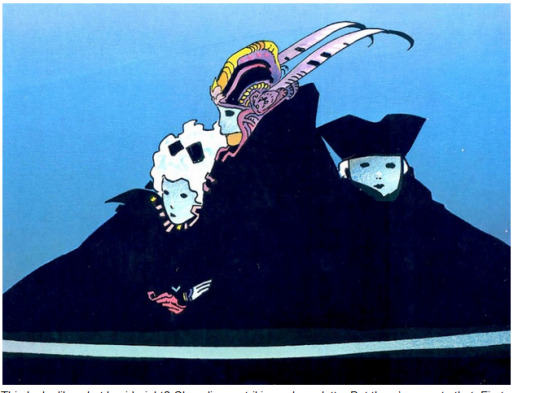
This looks like what I said, right? Clean lines, striking color palette. But there’s more to that. First of all, the fact that the gigantic flat black shape at the bottom of the piece conveys simultaneously the impression of the girl on the left leaning against the chest of the central figure and the boy on right fading into the back of composition while not containing any detail itself should clue you in to how much of a master good o’l Gir is and how much thought and knowledge had to go into designing this piece. There’s more.

If we zoom in on the head we can learn a bit. This is the focal point of the piece and, as such, this is where all the detail is. Where lines are used sparingly throughout the rest of the comp, here they provide an abundance of detail for the central figure’s elaborate headdress with contour lines defining the shape of the yellow crest and other lines throughout intimating textile patterns. The colors are striking but they’re not just random bright colors.

There’s the light blue of the background, a smattering of desaturated purple/red colors in the headdress, and the yellow of the crest. Let’s look at a color wheel:

You should notice that yellow is on the opposite side of the wheel from the entire blue-purple section. Yellow contrasts with blues and purples. Thus, just that tiny bit of yellow is enough to make it totally pop out from the rest of the more desaturated blues and purples in the piece. So, not just some random bright colors, but some carefully thought out areas of low and high color contrast.
Let’s look at another example:

A small piece but so effective. Notice how in the top, the horizontal lines begin super tightly packed and spread to create a gradient from pack to white. Notice how the line weight increases between the shadowed and light sides of the mushroom cloud to brilliantly indicate a core shadow. Notice how the horse and rider are mostly just black shapes- but they’re composed in such a way that your mind knows exactly what they represent. Notice how the hatching that creates the ground texture also points towards the cowboy’s head as a focal point.
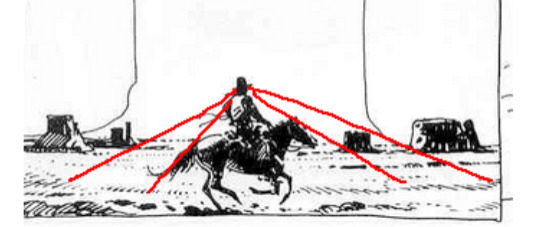
Another one:

Look at the linework on this. The way he varies the lineweights to indicate changes in value. The way each line describes the form of the figure and his clothes. How the lines create texture. No line here was put down by chance- each one has a purpose and Moebius knew the purpose of every mark he put on a paper.
So, I guess part one of my answer is you gotta really put the work into being a good artist and use Moebius as your guide. Get good with pens, be able to vary your lineweights, be confident with all different kinds of hatching styles, etc. Read up on color theory and see how Giraud applied it. Every new thing you learn, take that knowledge and use it to study your favorite artists and see how they applied it. That’s how you learn.
There’s a little more though and this applies to the content of Moebius’ art.
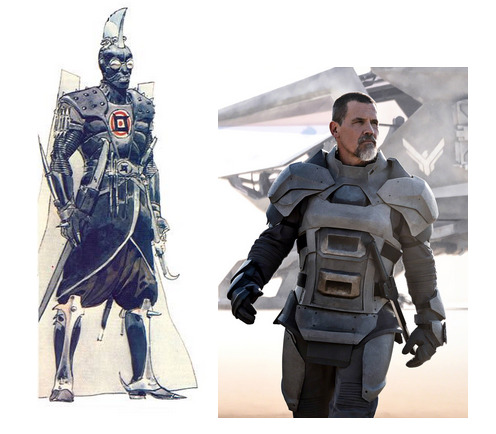
Here’s a side-by-side comparison of the Moebius’ concept art for the unmade 1970’s Dune movie with a screenshot from the new Dune movie. What makes them different? As bizarre as the Moebius design is, it feels a hundred times more real to me than the armor pictured on the right. There’s a specificity to it. Where the Moebius design feels like the result of generations of tradition and culture resulting in an outfit as elaborate, unconventional, and distinctive as that of an Ottoman Janissary, a Landsknecht, or a Samurai, the image on the right looks like a generic assemblage of armor plates with no history behind them.
As fantastic as Moebius’ work is, it definitely has a basis in the real world. I mean, he spent years illustrating a gritty, down-to-earth cowboy comic. All his designs feel distinct and specific and I would venture to say that a lot of that comes from taking an interest in real world cultures and traditions.


I think this is true of all real good science fiction and fantasy artists. They know how to take something from the real world and twist it to their own ends.
I hope this answers your question and helps you find joy in creating art. That’s what it’s all about.
For more reading, here’s a William Stout article on the subject: https://www.williamstout.com/news/journal/?p=3806
As a postscript, I’ll include some other artists that I think anyone who is a fan of Moebius should check out.
Sergio Toppi:

Katsuya Terada:

Katsuhiro Otomo:

Mark Schultz:

325 notes
·
View notes
Note
Why does bismuth look like that?
If you’re referring to its rainbow of colors, I’ll refer you to my post about thin-film interference.
If you’re asking about the shape of the crystals, that comes down to a couple of things.
Under normal circumstances, all metals form into crystals when they solidify. These crystals, called grains, are generally really small and without special preparation, there isn’t enough visual contrast between them to be able to distinguish individual ones
(Side note: traffic light poles and highway guardrails are galvanized, meaning they’re coated in a layer of zinc to protect against corrosion, and you can easily see the individual grains of their coatings—each splotchy section is a separate and distinct grain and I find it so friggin cool to be able to see individual metal grains with the naked eye)

Anywho, solidification to form crystals requires diffusion of atoms from the liquid, where atoms can move around freely, to the solid, where they sit in an ordered arrangement called a crystals lattice. In the case of bismuth, it has a rhombohedral structure, which looks like if you made a cube but instead of using squares for sides you used parallelograms:

But that doesn’t answer the question, because there are lots of rhombohedral metals and compounds that don’t make the funky hopper shape we see in bismuth crystals!
To form crystals that look like the above picture on a large scale, you need atoms to diffuse and join the crystal structure evenly all over, that way there isn’t a weirdly protruding face or edge from getting more growth than the others
In the case of bismuth, due to a combination of factors at the atomic level (electrostatic interactions, interface energy variations, diffusion rates dependent on orientation), atoms arrange themselves on the edges of the crystal far faster than they do on the faces. This means that rather than the plane of a given face just extending outwards, the edges grow much faster, giving the hopper shape, which is basically made of edges with very little face growth.
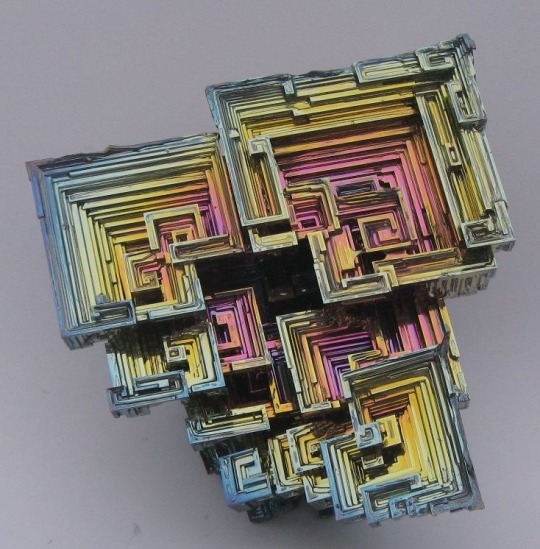
Creating crystals like this is very difficult. It requires a very slow, controlled cooling and solidification of the bismuth—if it cools off too fast, then tons of crystals (grains) will form all through the liquid, and it’ll solidify looking like just a chunk of any other metal.
38 notes
·
View notes
Text
“...First, let’s talk about materials. We can rule out a Steppe Nomad inspiration for any of this right off. The Eurasian Steppe is very large and covers a range of arid climates (that is to say, parts of it are colder, parts of it are warmer), but they all have spinning and weaving technology, by which the supple hairs of woolly animals, or plant fibers like linen, or cotton, or even natural protein fibers like silk can be fashioned into fabric which is more flexible, comfortable, breathable and temperature controlled than the raw leather we see in the show.
...there is a distinct lack here of lots of leather, except in the sort of things that lots of cultures use leather for (boots, fittings, saddles, bags, tents). Instead, clothing is mostly made out of nice, comfortable, breathable textiles, because of course it is. That is not to say, to be clear, that leather or hides or fur were never used – fur especially was used; merely that they were generally used to supplement clothing primarily made out of textile.
...Now Plains Native American clothing does make much greater use of animal skin as a clothing material, but there is an important distinction to be made here. The problem here is with the plasticity of the term ‘leather’ which can technically include a wide range of products, but in practice is understood to mean exactly what the Game of Thrones costume department and literally every piece of official artwork of the Dothraki understand it to mean, which is the product of tanning processes.
I am not an expert, but as far as I can tell, Native American clothing was not made in the same way; animal products were used in a process I have seen described as ‘brain tanning’ (rather than using chemical tannins) and the final product was then smoked. The result – which is often called ‘buckskin’ regardless of the animal source for the hide – is very different from the leather we see in the show.
This is, in terms of material, very clearly not what the ‘vests’ the Dothraki in the show are wearing. Buckskin would also be used to make trousers, as opposed to the “horsehair leggings” of Martin’s wording, which also strike me as deeply improbable. Haircloth – fabric made from horsehair (or camel hair) – is durable, but typically stiff, unsupple and terribly itchy; not something you want in direct contact with your skin (especially not between your rear end and a saddle), unless you just really like skin irritation. It is also a difficult material to get in any kind of significant quantity – and you would need a significant quantity if you intended to make most of your trousers out of it.
...Well that’s for materials, what about patterns? Once again, we can quite easily rule out anything steppe inspired. Again, the Eurasian Steppe is big and has lots of variety, but relatively long robes are generally the norm in terms of dress; where long robes were not worn (see our Scythian above), the common pattern was heavy sleeved garments and trousers with very complete coverage. A common example of the type of long robe-like garments is the Mongolian deel, a long sleeved robe or tunic which provides a lot of protection against the elements. In the case of elites – and Daenerys is, initially, mostly around elites – these could be made of expensive silk or brocade – but poorer versions might be made of wool.
...And there is good reason for these relatively high-coverage garments. Plains or Steppe peoples naturally tend to live on, well, plains and steppes – that is large expanses of semi-arid grasslands. The very nature of that terrain configuration produces fairly extreme seasonal temperature variations (that is, very hot summers and very cold winters) as well as extreme daily temperature variations (that is, hot days and cold nights) because such places are far from large bodies of water and also don’t have tree-cover, both of which serve to moderate rapid temperature changes.
Consequently, as anyone who has lived in a plains state in the USA (or on the Eurasian Steppe, though that is fewer of my readers, but for my brave handful of hits from that part of the world, hello and welcome!) can tell you, you need clothes that can be layered and which can be both warm in the winter and cool in the summer. For us moderns, we mostly do this by owning multiple season-specific wardrobes, but clothing is expensive in pre-modern societies, so multi-purpose garments, or garments that be layered, to turn a warm-weather outfit into a cold-weather outfit are important!
There’s no reason to suppose the Dothraki Sea would be any different: it sits at about the same latitude as King’s Landing so there is little reason to assume it would be warm all-year-round. Parts of the Eurasian Steppe stretch decently far south, sharing a latitude with northern Italy and Spain; nevertheless they do not enjoy the same Mediterranean climate because they don’t have the same exposure to the weather patterns created by the sea. The southern end of the Great Plains stretches down all the way into Texas, but still gets properly cold in the winter with temperatures regularly dipping below freezing in the winter despite the latitude. For a people who are camping and working outside all of the time, warm clothing is going to be a must.
...There is tremendous variety here, but I don’t think any of it could be aptly described simply as “Men and women alike wore painted leather vests over bare chests and horsehair leggings.” Now, if you looked hard enough could you find something that resembled Martin’s leather vests, bare chests and horsehair leggings somewhere in the clothing of Native Americans across two continents? Probably, but among the specific Native peoples that Martin cites as inspiration, it does not seem to be at all common. And if that description was wholly unconnected to anything in the real world, we might well stop there and conclude that, well this is just the ‘dash of pure fantasy’ that Martin was talking about (although as we’ll see, it is going to be quite a bit more than just a dash). But I don’t think we can stop there, because (removing the medallion belts) Martin’s description does adequately describe something that exists in the real world: Halloween costumes purporting to depict Native Americans.
...The vest-and-pants style of Native American Halloween costume seems to be rather rare now, but it was, at least to my memory, much more common in the 1990s, when A Game of Thrones was written (initial publication date of 1996). You can see them, for instance, on many of the background extras in the famous Thanksgiving scene from Addams Family Values (1993) and that vest style was also a part of the outfit for the also-quite-unfortunately-branded YMCA Indian Guides/Indian Princesses program (rebranded as the ‘Adventure Guides’ in 2003 after decades of Native Americans complaining about it) which was also fairly popular in the 1990s.
Now, I am not saying that Martin planned to construct his Dothraki out of Native American stereotypes and bad Halloween costumes. In fact, I am fairly confident he intended nothing of the sort. But in the absence of doing some effective research (and it is going to become increasingly apparent that at least effective research was not done) there was quite possibly nothing else to inform the effort other than what was ‘in the air’ of the popular consciousness. Of course the danger of those often simplistic public stereotypes is that people often do not know that they have them, assuming instead that the vague impression they have is essentially accurate (or at least, close enough for a regular person). And that’s a real problem because it reinforces the popular stereotype, especially given Martin’s reputation for writing more ‘historically grounded’ fiction. And that is a problem because…
The clothing that the Dothraki are described and visually shown wearing is clearly intended to convey things about their society. Returning to our visual comparison above, it is easy to see that the actual clothing of both Eurasian and American ‘horse cultures’ was often bright, highly decorated and generally eye-catching, featuring complex patterns and shapes. It was both nice looking, but also spoke to the humanity of the people that made it and their very human desire to look nice and have nice looking things. By contrast, the clothing of the Dothraki is presented as simple, rugged and unadorned.
...I want to stress this to make the point clear: people in the past liked to look nice! Much of the popular perception of pre-modern clothing assumes lots of dull, drab colors, undecorated or merely adorned with rough pelts, but this is almost entirely a Hollywood construction. The Romans didn’t exclusively dress in white (indeed, the toga candida, the white toga, was an unusually formal thing to wear, like a politician’s suit-with-flag-pin), medieval peasants didn’t wear drab brown (they dressed in bright primary colors mostly), and as I hope the historical pictures for this essay show, both steppe nomads and Plains Native Americans wore nice clothing with lots of patterns, color and decoration. These men next to Khal Drogo are his elite guard of ‘bloodriders,’ the companions of a ruler who wields tremendous power and wealth! And yet they have opted to wear mostly undecorated bland brown leather.
Just to underline this point, think about what a fine set of clothing communicates to an observer (for instance, one of Khal Drogo’s thousands of mounted warrior retainers who are present at this event). Imported goods, like metalwares (which nomads won’t generally be able to make themselves) or fine imported fabrics demonstrate not only trade contacts but also often that the leader has useful ties to foreign leaders (since such things were often gifts or tribute from foreign courts). Garments whose production, due to fine patterns, complex weaves, intricate beading or quillwork, would take many, many hours of production demonstrate that the leader has a lot of subordinate people in their household (in many cases, that would mean women), which both implies the ability to give these people as gifts (either in marriage or because of their non-free status) and also the access to resources (in this case herds of animals) needed to sustain so many people – in short, the sort of leader who can reward faithful warriors richly.
And of course a leader who outfits his closest retainers – his bloodriders, in this case – with such wares (especially expensive foreign metal military equipment) demonstrates both access to military capital and also the ability to reward his trusted lieutenants. In short, the Khal whose person and immediate retainers are decked out in finery looks like backing the winning side, which is a very important thing to assess as one of his warriors. So even if not one of Drogo’s men cares about their personal appearance at all, it is still politically important for them to dress for success.
Which then demands the question, looking at the very fine clothing of historical horse cultures that supposedly provided the inspiration for these Dothraki fellows: Where is the exquisite bead work? The fine quillwork? Where are the carefully made fringes? Where is the silk brocade? Where are the detailed, complex patterns?”
- Bret Devereaux, “That Dothraki Horde, Part I: Barbarian Couture.”
53 notes
·
View notes
Text
Ranking : David Lynch (1946-present)

Film is definitely an art, and yet, it seems to be distinct from other forms of visual art such as painting or sculpture. Perhaps that is what makes David Lynch such a fascinating director, as he has the ability to tap into the surreal stimulus often found in the most famous paintings and transform it into brain-bending moments on film. Whether it his fear-fueled fascination with fatherhood present in his debut film Eraserhead, his ruminations on Hollywood society present in Inland Empire, or any of the stopping points in-between, it’s safe to say that David Lynch sits in the rarified air of directors like Ingmar Bergman, Alejandro Jodorowsky and the other few who can turn film into something deeper, more visceral and more meaningful.
With one of the most unique collections of films credited to his name, including a couple of curveballs in the early portion of his career, ranking the films of David Lynch is as perplexing as it is entertaining... so, without further ado, we attempt to climb that hill. I’m not even going to pretend that I can break down all of the symbolism and meanings of these films, but I can give my honest opinion about them.
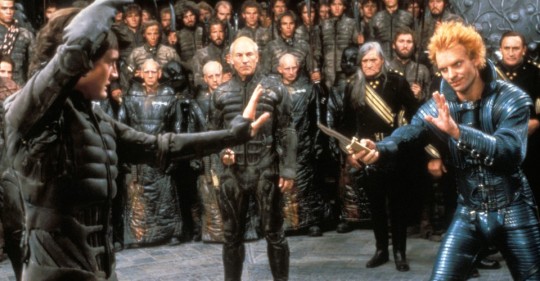
10. Dune (1984)
For a film that is supposed to be such a science-fiction gem, it’s a bit funny that nobody can seem to make a coherent, entertaining version of Dune. After nearly 15 years in pre-production hell (and three iconic names attached to versions of the production), the film landed in the laps of Dino De Laurentiis and Ridley Scott, but after another extended period delaying production, Scott bowed out, leaving the door open for David Lynch to step in. For what it’s worth, he did bring a huge list of names to the project, but the fact that the directing credit for Dune belongs to the throwaway pseudonym Alan Smithee should clue in any perceptive viewer that the project may not be one that Lynch cares to stand behind.
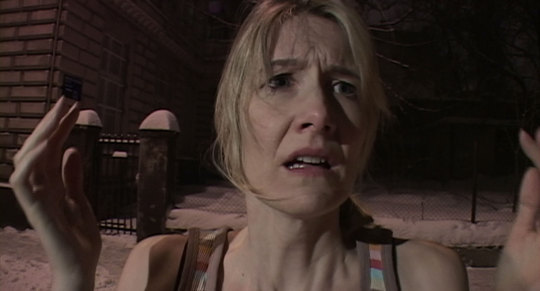
9. Inland Empire (2006)
David Lynch isn’t the type of director that revisit ground he’s already covered, which is what makes Inland Empire (the seemingly final film from Lynch) such a confusing choice. Had this film not been released after a five year gap between it and the stellar Mullholland Drive, another film that focuses on the dark underbelly of Hollywood, fame and the tolls of the acting craft, perhaps it would hit a little different to me. That’s not to say that the film isn’t good, as it is definitely a slight adjustment from the style that Lynch basically trademarked, but when a director like Lynch experiments on what feels like general principle, it makes experiments that feel like a step backward lose impact.

8. Lost Highway (1997)
Technically, you could count all of the Lynch “mystery” films as noir in some capacity, but Lost Highway feels like a direct skewing of what we know as the traditional noir structure. At its core, the film is a simple murder mystery, but it doesn’t take long for the Lynch signatures to begin appearing in every form from a mysterious, unnamed character to our protagonist literally changing into another person with no base explanation provided. Perhaps the latter choice was a look into split personalities and the disassociated nature that can come with brutal crimes... as I said before, I’m not here to try and decode the David Lynch mystery. While Lost Highway serves as a good entry point into the David Lynch catalog, it sits on the back half of the rankings due to no fault of its own... it’s more of a situation where the other mysteries are so stellar, that even the strange seems simplistic by comparison.

7. The Straight Story (1999)
If you played a game of “one of these things is not like the other” with the films of David Lynch, it would not be difficult to make a winning choice, as The Straight Story is clearly the most accessible and standard of all the Lynch fare. What the film lacks in oddness and style, however, is more than made up for in terms of heart and performance. The use of a lawnmower as the main source of travel allows for some beautiful landscape cinematography, and the sheer force of will exhibited by Richard Farnsworth pays off in spades when he is reunited with Harry Dean Stanton. If you’re looking for something creepy, eclectic and mind-warping from Lynch, there are plenty of other films to choose from, but if you are looking for an excuse to shed a tear or two, this is the film for you.
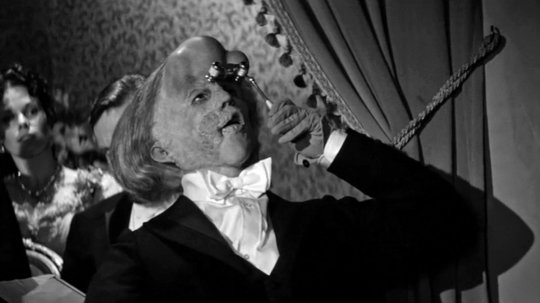
6. The Elephant Man (1980)
It’s funny to think that if not for The Straight Story, the Joseph Merrick biopic The Elephant Man would serve as the most normal film of the Lynch canon. This sophomore film dialed back on the abstractions present in Eraserhead, but it brought some extraordinary makeup and costuming to the table, not to mention it gifted viewers with a powerfully moving performance from John Hurt. Though memorable in its own right, the film really made its mark by tying Raging Bull at the 53rd Academy Awards, garnering eight nominations (and sadly losing in all categories, going home empty-handed). The backlash for the Academy’s lack of giving The Elephant Man special praise for its makeup effects also led to the creation of a Best Makeup award for the Oscars. It is quite possible that the combination of shock from Eraserhead in tandem with the skill and prowess shown in The Elephant Man opened all of the creative control doors for David Lynch, as not even Dune could derail his career and artistic oddness.

5. Blue Velvet (1986)
While Twin Peaks is where I first heard the name David Lynch, it was Blue Velvet where I first got a taste of why Lynch was held in such high regard. The suburban paradise presented in the opening credits is immediately shattered by the discovery of a random ear, and the weirdness rabbit-hole gets deeper and deeper from that point on. The classic look of the film stands in powerfully beautiful contrast to the extreme darkness of the narrative, and Dennis Hopper turned it all the way up to 11 for his performance in the film. If Lost Highway serves as the best introductory film for those curious about Lynch, then Blue Velvet serves as a good midpoint to determine how much weirdness, abrasiveness and shock you can handle in a Lynch film.

4. Mulholland Drive (2001)
I really and truly do not know where to begin with this insane rollercoaster ride of a film. The first time I watched this film, I thought I had everything figured out, every mystery solved and every bait and switch identified, but upon repeat viewings of Mullholland Drive, I’ve determined that I either had a brief moment of harmonic brilliance or I was fooling myself. The film makes sense at its root, if really and truly dissected, but when taken at face value and in real time, it’s almost impossible not to get completely lost in the sheer immersive nature of everything thrown at you. Naomi Watts is brilliant as the viewer guide through the film, and it’s good that she is so powerful in her lead role and guiding task, because Mullholland Drive is not afraid to get downright bonkers on more than one occasion. While films about the trappings of Hollywood and stardom are nothing new, I’m hard pressed to think of another film that approaches these in a manner even remotely close to that of Mullholland Drive.

3. Wild at Heart (1990)
Quite possibly the most enjoyable of all the David Lynch films, despite some downright brutal moments of celebratory violence sprinkled throughout. The combination of Nicolas Cage and Laura Dern is nothing short of electric, and the presence of Willem Dafoe as antagonist is the perfect spark to ignite an already volatile mixture of leads. The energy level of this film starts on ten and only continues to rise as the film progresses. If/when I ever get the chance to program theater showings, I am putting this film on a double bill with Natural Born Killers immediately. While I can’t say that Wild at Heart is my favorite David Lynch film, I can say without a shadow of a doubt that it’s my favorite Lynch film to gush about with other fans.
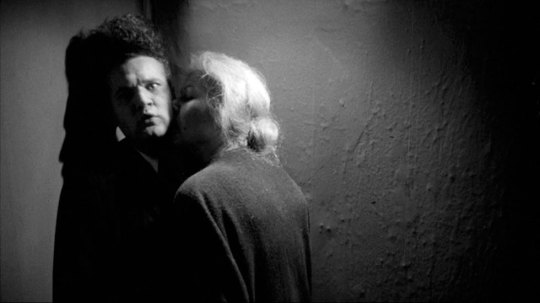
2. Eraserhead (1977)
More often than not, directors the caliber of David Lynch have stunning debut films to their name, and Lynch certainly exploded onto the scene with a gamebreaker in the form of Eraserhead. Upon first viewing, there is enough “WTF?!” going on to confuse most people, but for those brave enough to watch the film more than once, it becomes painfully obvious that all of the madness and shocking imagery on display is a clear metaphor for Lynch’s fear of fatherhood. The simple act of taking a fear that resonates with most humans and turning it into the equivalent of a black and white bad drug trip works perfectly, and Jack Nance’s iconic look and performance are almost recognizable enough to know without knowledge of the film. Eraserhead is one of those films that leaves you different than you were prior to watching it.
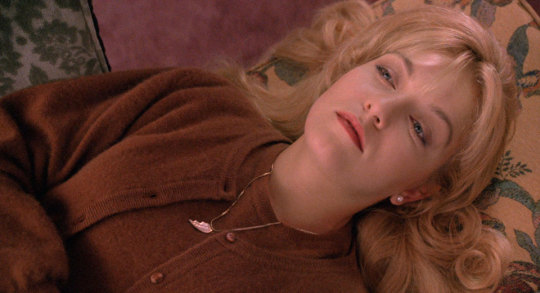
1. Twin Peaks : Fire Walk with Me (1992)
In all honesty, was there every any doubt that Twin Peaks : Fire Walk with Me wouldn’t be in the top spot? Of all the properties that the David Lynch name is connected to, none of them have even come remotely close to touching the sheer size of the lore and fandom that has emerged from this modern day masterpiece. The story of the high school princess with deep, dark secrets to hide is not new territory, but the way that Lynch handles it all with Twin Peaks takes the familiar to all new realms of weirdness, including the creation of iconic places and characters like the Black Lodge, the Log Lady, the production mistake that created the infamous Bob, and the eternally iconic Laura Palmer, and oh yeah, the film’s not half bad either. I doubt that David Lynch ever had any intention of reaching the heights of fame that Twin Peaks : Fire Walk with Me afforded him, but it would be dumb to think that he isn’t impressed with the magnitude of the world he created based on that single idea for a film.
#ChiefDoomsday#DOOMonFILM#DavidLynch#Eraserhead#TheElephantMan#Dune#BlueVelvet#WildAtHeart#TwinPeaksFireWalkWithMe#LostHighway#TheStraightStory#MullhollandDrive#InlandEmpire
23 notes
·
View notes
Text
loki appreciation agenda continues because i am speculating on the reasons why goro can change outfits. this is a super speculation-heavy post on goro’s outfit-changing abilities based on theories that loki was created through experimentation to force goro to awaken a second persona, and i don’t think i can necessarily “prove” anything in this post, but the lore on how personas work surprisingly checks out so it’s plausible if nothing else.
anyway, i think goro has two different outfits because he awakened to his “first” persona, twice.
explanation under cut:
(FIRST of all, i know there’s doylist explanations for why certain characters get new outfits and others don’t. this is a watsonian explanation because i have goro akechi brainworms and i cannot stop thinking about my boy.)
the basic premise is that your outfit is something you get when you have the will to rebel. outfits manifest when you’re in a palace that sees you as an enemy, thus activating your rebellious spirit to tell them to suck a dick.
that rebellious spirit comes from a moment of resolve: knowing that you don’t want to die, knowing what it is that you fight for, and knowing whose ass you want to beat. usually, then the character manifests a mask, hears the voice of their persona inside them, and they rip it off.
the will of rebellion also typically triggers a character awakening to their first persona. i’m going to call it the starter persona.
insofar as i can tell, a starter persona is a very specific type of persona that comes from a very specific type of phenomenon:
the manifestation of your resolve/will of rebellion
the persona you get when you awaken to your persona-using abilities for the first time
the first form of your persona
a persona that is unique to you and your soul
theoretically a persona that comes from within you, rather than an external source (e.g. shadow negotiations or the velvet room)
a persona gained under extreme duress marking a drastic resolve in oneself
a starter persona is not:
an evolved edition of your starter persona due to a moderate change in yourself (second-tier/third-tier awakening)
a new persona gained through capturing a shadow (akira’s new personas)
a new persona gained through fusing pre-existing personas (velvet room)
when a second-tier persona occurs, or a new persona is gained through shadow capture or fusing, a new outfit is not gained, because outfits come with the starter persona only.
so my theory is that robin hood and loki are both “starter” personas, even though loki was gained ostensibly way, way after goro had awakened to his general ability to summon personas. loki is not a persona that was gained through shadow negotiations or the velvet room, and loki is not an evolved form of robin hood, since robin hood and loki coexist and first-tier personas disappear when they turn into second-tier personas.
loki is basically as if goro underwent his first awakening, but a second time, and that’s why there’s a separate outfit for him, in the same way that all the phantom thieves get an outfit when they awaken for the first time.
and now i’m going to go into way too much detail about how starter personas are a very hyper-specific phenomenon that are different from the wild card ability to gain multiple personas and are also different from second-tier awakenings:
CASE ONE: wild cards
wild cards demonstrate very well that starter personas are unique in that they’re created from within a persona user, whereas other personas that wild cards can wield must come from outside sources. and even for wild cards who have six jillion personas, they really only have one starter persona (and in akira’s case, one accompanying outfit).
i think it’s alright to assume there’s something unique about arsene in relation to akira, in the same way that izanagi is unique to souji or orpheus is unique to minato. every other persona that these wild cards get have to be gotten from either capturing shadows in the wild, or from fusing captured shadows in the velvet room. they’re personas that are found from outside of the wild card, and then taken in to become one of the wild card’s masks.
by contrast, arsene, izanagi, and orpheus seem to come from “within” the wild cards, in the same way that any non-wildcard undergoes an awakening to pull a persona from inside themselves. arsene, izanagi, and orpheus aren’t gained through capturing a pre-existing shadow or fusing pre-existing shadows. so even though akira and other wild cards can wield multiple personas, all of them only have one starter persona.
i’d theorize that, although wild cards have the ability to wield many different masks, the other personas are more like impermanent additions to the general ability to wield multiple personas, which comes with the starter persona. (arsene and izanagi in particular seems really stick around even when you fuse him away, especially since arsene comes back in a second-tier awakening as satanael and izanagi as izanagi-no-okami.)
(NOW THAT I’VE SAID THAT, according to persona lore, all personas come from the sea of the soul! i did not forget. when i’m making the distinction between a persona that comes from “within” a persona user and a persona that has to be found externally, i mean that all shadows/personas ultimately come from the vast sea of the soul/collective unconscious that connects all human beings, but these personas get obtained through different ways: starter personas seem to be summoned from the sea of the soul entirely internally, whereas other shadows have to be summoned from the sea of the soul from either finding them in palaces, mementos, or the velvet room.)
akira, obviously, does not get a new outfit every time he gets a new persona, although that would have been cool as fuck. the outfit happens only when the starter persona is awakened--the persona from within akira, rather than a persona he acquired from the outside.
CASE TWO: general persona users and second tier awakenings
normal persona users don’t have the ability to find external shadows and make them into their own persona. normal persona users have only their starter persona which they got from within themselves, in the same way arsene is unique to akira, and are born from a moment of internal resolve. their personas are all “internal affairs,” so to speak.
normal persona users also have the option of a second-tier awakening, though. second-tier awakenings involve only the starter persona, a new resolve in the character, and again seem to be a persona that comes from “within.” so it seems a bit like the persona user has “awakened” a second time. it’s certainly an entirely internal event, requiring no additional personas obtained from palaces, mementos, or the velvet room.
but the second-tier persona is not an entirely new starter persona. second-tier personas are just their pre-existing already-awakened starter personas changing into a slightly different persona with the same abilities. second-tier personas inherit all the stats and abilities from the first as well, a bit as if it’s just the starter persona in a different form. so although the phantom thieves “awaken” a second time, it’s not so much an awakening so much as it is just an evolution of a pre-existing persona.
this makes sense in terms of the “personas manifest as a will/resolve to rebel” logic, too. it’s not necessarily that they manifested an entirely new resolve to rebel; their pre-existing resolve to rebel just evolved, changed, or was reaffirmed.
there’s also a visual cue for this: awakening a starter persona is a whole fucking deal involving a stressful situation, thinking you’re going to die, usually having to face some asshole in your life who abused you, hearing voices, screaming, manifesting your mask and ripping your face off. second-tier awakenings don’t involve this lmao. god could you imagine if it did. it’d actually be so funny tbh
second-tier awakenings, also, seem to be a phenomenon specific to “starter” personas, or personas obtained from within. you wouldn’t see a persona that akira got from a shadow negotiation evolve in the same way that arsene evolves into satanael, or carmen evolves into hecate, or izanagi evolves into izanagi-no-okami. you could argue that “high pixie” is a second-tier of “pixie,” but there’s no way to make pixie have new resolve and evolve into high pixie like a pokemon; pixie would have to be fused with some other persona to create high pixie. personas obtained through external means have to be fused with other personas, or absorb the life force of other personas through executions.
anyway, to get back to the point about goro’s two-outfit deal, second-tier awakenings also don’t get you new outfits. which makes sense if we assume that outfits come with obtaining a starter persona, since second-tier awakenings are just your starter persona evolving and is not actually an event in which you obtain an entirely new starter persona.
CASE THREE: haru and sumire
weird fact i forgot until i wrote this meta!! but both haru and sumire are cases of people who got their outfits and a “semi-awakening” to their personas, that then led to a period of not quite being able to actually summon their persona. so, from what we can understand, their will to rebel is there, just not solidified enough to manifest a persona.
morgana, our resident lore expert, tells us that when haru has her outfit but not her persona, milady is more or less there already, just confused due to conflicted feelings about haru’s father, and therefore can’t fully take shape. so she can sort of summon milady, but just not in an effective way that can deal battle damage.
personally i think this is just the atlus writers creating a reason to have haru in the palace in cute clothes without having her go through an awakening, so that she could awaken later for full dramatic effect. but since morgana went to such lengths to explain the mechanics of it and tell us that milady is technically already there, it’s a really interesting case study that demonstrates outfits are not something that are specific to having a starter persona, but doesn’t guarantee that that persona can be summoned.
the same thing happens to sumire: she gets her outfit sometime in october, and for some reason can use cendrillon up until she remembers that she’s sumire and not kasumi. then she winds up in a state like haru’s, where she has an outfit, has the will to rebel, and technically even has cendrillon, but she just can’t summon cendrillon. then she has to go through the whole song and dance of ripping her face off to awaken to cendrillon (which might be kasumi’s soul depending on the interpretation of the scene). and of course, from there her starter persona can have a second-tier and third-tier awakening to vanadis and ella.
but it looks like the same case as haru, ultimately: she technically had cendrillon, but wasn’t able to use it or manifest it because her resolve was jank as fuck with all her identity issues.
SO BASICALLY:
what i’m getting at is that the outfits come from awakening to a starter persona only.
a starter persona is, as shown above, a hyper-specific phenomenon in which you pull a persona out of your soul, as opposed to capturing an external shadow and adding it to your pre-existing persona abilities, or transforming your pre-existing persona into a new one. awakening your "first” persona is a thing that happens only when you dig up all the weird sediment from your soul when you think you’re going to die, generally. starter personas come from a moment of internal resolution, and the resulting persona seems to be unique to that person and the circumstances of the persona’s awakening.
really, it’s such a theatrical ordeal, too. like i mentioned before, starter personas get obtained through this WHOLE fucking ritual involving stress, hearing the voice of your persona inside you, manifesting your mask, ripping your face off, manifesting your outfit, etc, etc. (i think it’s fairly important to note that ripping the mask off is the first instance of the larger outfit showing up, too; the mask itself, the outfit, and the starter persona seem to come hand in hand.)
we already know that loki is not a second-tier awakening of robin hood, because robin hood co-exists with loki. we also know that loki is not a persona gained through shadow negotiation or fusion, because external personas that are gained through those methods don’t come with an outfit.
so it really looks like goro just manifested the internal will to rebel, and the accompanying new outfit and entirely new persona, twice.
this, actually, fits really well with the medical experimentation thing, since starter personas, the will to rebel, and the outfit seem to come from stressful situations, where the persona user, in an attempt to not die, pulls a new persona out of their soul from no external source. if the featherman game is implying what i think it is, shido’s scientists and maybe wakaba were trying to force a persona out of goro with stress and trauma, in the same way that you’d manifest a persona for the first time. these scientists were not handing him shadows to turn into personas, like how the wild card is intended to be used. these scientists were not trying to transform robin hood into a new form, like how a second-tier awakening is supposed to work. they were inducing the same conditions that you’d need to awaken a persona for the first time.
it also makes sense from an in-universe perspective, because i’m assuming that, since goro and these cognitive psientists didn’t know jack shit about the metaverse at the time, goro just told them what he knew about persona awakenings: he awoke to robin hood under duress, he reached into his soul, found robin hood there, did a bunch of yelling, pulled off his face, BAM. robin hood. so the scientists said, well, if you wanna see a phenomenon a second time, you might as well recreate the conditions from the first time, right? make him pull off his face again and see what happens.
that would explain how loki is unique to him, in the same way that arsene is unique to akira, or any of the other personas are unique to their phantom thieves. it would explain why there’s an accompanying outfit to go with loki as well--it’s literally an entirely different “first” awakening, as if he manifested the ability to summon a persona twice, rather than just adding on new personas to his pre-existing ability. and it also explains how he has two unique personas that are separate from each other.
it also explains why he never seems to, say, use robin hood while in the black mask outfit, and why he never uses loki while in the white crow outfit. it’s not a cosmetic choice; the outfit is tied to the persona he’s using at the time. the outfit is tied to the separate awakening, and the separate “first” persona that was generated from that awakening. (EDIT: goro does actually use loki very briefly while still in the white crow outfit during his boss battle, although presumably loki is not “fully” summoned because loki is blacked out/colored strangely/vaguely see-through.)
(meanwhile, hereward doesn’t get a new outfit to match him because he’s a tiered transformation awakening. a pre-existing power gets transformed. hereward even existing is also good evidence that robin hood and loki are “starter” personas rather than personas gained through external means, since shadows obtained through mementos/palaces/velvet room don’t get tiered evolutions.)
which is a really interesting bastardization of the wild card ability, if that’s actually what happened. because he’s a wild card with the ability to wield multiple personas, he was able to awaken for the “first” time twice and wield two different personas, but in an extremely corrupted way, not at all the way that wild card abilities are intended to be used.
and i know that this is all just speculation at this point, but it does make hereward look a little bit like goro managed to finally fuse together the two “corrupted” halves of his wild card ability into a singular, whole persona. something or other--growth can only occur when thesis and antithesis synthesize? ...something like that.
anyway i’ve never felt so much like matpat in my life.
270 notes
·
View notes
Video
youtube
Great Albums is back! This week, we’ll take a look at one of the greatest electronic albums of all time, Kraftwerk’s The Man-Machine, and try to avoid getting sued by Ralf Huetter! Full transcript for the video can be found below the break. Enjoy!
Growing up, my main genre of choice was 80s synth-pop, and while the deep influence of Kraftwerk is as significant there as it is everywhere else in electronic music, I was one of those people who initially saw them as somewhat "intimidating." Today, moreso than ever, Kraftwerk are held up as one of those more high-brow or cerebral groups with a philosophy that transcends mere pop or dance music, which makes them seem respectable, a kind of “model minority” in the world of music outside rock. While I don’t buy into the judgmental quality of that sort of praise, which damns so many of Kraftwerk’s greatest fans and imitators, I did get the sense, as a child, that these hoity-toity Germans, working with primitive equipment way back in the 1970s, might not be what I was looking for in a new favourite band. That was before I heard The Man-Machine.
While it’s certainly true that Kraftwerk were a highly experimental band in their own time, they’re one of those acts whose ideas have deeply permeated contemporary music, to the point where their actual work is extremely approachable and listenable to today’s ears. Of all the fairly early electronic acts, who started making this kind of music before it began to become mainstream in the late 70s, Kraftwerk are almost certainly the ones people nowadays listen to for pleasure the most, and that’s no accident. While their earlier albums like Trans-Europe Express took more overt inspiration from classical music, The Man-Machine was their first great foray into the arena of pop, which I think is key to why it resonates with people. For evidence of that, look no further than the biggest mainstream hit of Kraftwerk’s career, “The Model.”
I think it’s easy to see why “The Model'' became a hit single. Sure, it may not have the most traditional pop song structure, let alone instrumentation, but unlike a lot of what Kraftwerk had done before, it’s got a lot of lyrics and a real sense of narrative. Plus, that narrative we get is about a person and not a machine--a good-looking person, in whom the narrator is sexually interested. It’s the perfect pop material. Of course, I would be remiss to mention that “The Model” didn’t achieve all of its success until the single was re-released in many markets in 1981, and in those few years, the idea of “synth-pop” advanced significantly in the charts and popular consciousness. By the time “The Model” was a hit, Kraftwerk admirers were already taking over: look no further than Gary Numan’s "Cars” or OMD’s "Enola Gay,” two synth-pop classics that, it must be said, are still about vehicles!
That aside, though, not everything on The Man-Machine sounds like “The Model”--in fact, it’s surrounded by tracks that have much more in common with Kraftwerk’s earlier LPs. Literally surrounded, in the track listing. I think that adds to this album’s appeal as an ideal entry point into their catalogue: it has some things that sound familiar, while also preparing you for what else you’ll encounter if you choose to probe deeper into the band. The Man-Machine has the least homogeneous profile of any Kraftwerk album. While most of their other classic albums are highly cohesive “song cycles” that almost blend into one long song when you listen to them in full, The Man-Machine doesn’t really have those repeated melodies and motifs that tie its tracks together. While many people, especially fans of psychedelic and progressive rock, really like those cohesive albums, I think this change is a welcome one. It gives the individual tracks a bit more room to breathe and express distinctive identities, and makes the album feel a bit more pop, even if the material itself isn’t always all that poppy. *The Man-Machine* actually only has six individual tracks; they range in length from the three-minute pop stylings of “The Model” to the urban sprawl of “Neon Lights,” which luxuriates in an almost nine-minute runtime.
Given that the average track length is around six minutes, I’m almost tempted to think of The Man-Machine as six tiny Kraftwerk albums, or at least, musical ideas that could have been expanded into full LPs in another universe. “Neon Lights” and “Spacelab” feel dreamy and easy-going, with floating melodies that draw from the “cosmic music” scene, one of the many emergent styles that began as something uniquely German and spread throughout the world--in this case, becoming an important forerunner to ambient electronic music through acts like Tangerine Dream. Meanwhile, the hard, tick-tocking rhythms of “Metropolis” and the title track point to the newfound focus on rhythm and the so-called motorik beat that made the music of Neu! so compelling.
The Man-Machine can serve not only as an introduction to Kraftwerk, but also as a sort of crash course in this entire period of electronic music, showcasing some of the most distinctive and influential features of the German scene, as well as the shape of synth-pop to come. It’s a complex and busy historical moment with huge ramifications for almost all of subsequent electronic music, and The Man-Machine really creates a microcosm of that whole environment. There’s also the fact that each side of the record has one track from each of my three broad groups, like an expertly-designed sushi platter or charcuterie board for us to sample from, and they both follow the same formula: a pop appetizer, a cosmic *entree,* and motorik for dessert.
*The Man-Machine* also has what is almost certainly the most iconic cover of any of Kraftwerk’s LPs. This is how lots of us still picture them in our minds, and it’s inspired tons of parodies and riffs over the years. I think all of that acclaim is deserved! Emil Schult’s graphic design for the album was heavily inspired by avant-garde Soviet artists of the 10s and 20s, chiefly El Lissitzky. These visual artists used their art to express their hope for a new world, defined by the promise of technology, and their literally revolutionary philosophy--so what could be a better match for Kraftwerk’s electronic revolution in music? Lissitzky used bright, primary colours, straight lines, and geometric shapes to convey the “built environment” of modern cities and man-made architecture, and you’ve got all the same sentiment on display here. The use of strong diagonals really draws the eye and lends this image a lot of continued visual interest. It’s also worth noting the extent to which Kraftwerk’s aesthetics inspired later electronic acts almost as powerfully as their sound. When you picture an electronic band, and get a mental image of stiff and stone-faced musicians behind synthesisers wearing shirts and ties, you can certainly thank Kraftwerk for that, as well.
I also love the title of The Man-Machine! The relationship between people and technology is one of, if not the, most central themes in Kraftwerk’s entire discography, which is full of references to anthropomorphic machines as well as mechanically-mediated humans. The particular choice of the phrase “man-machine,” as opposed to words like “android,” has a fun vintage flair to it, which matches the use of early 20th Century visual art quite nicely.
As might be expected from the album’s stylistic diversity, *The Man-Machine* would prove to be something of a transition point in Kraftwerk’s career. Their 1981 follow-up, Computer World, would return to the song cycle format, but with increasing emphasis on ideas from the pop sphere, championed by percussionist Karl Bartos. By the time of the last classic-lineup Kraftwerk LP, 1986’s Electric Cafe, they had not only amped up the pop, but also incorporated influence from the electronic dance music of the time. Ultimately, Bartos would leave the group, chiefly due to discontent with his treatment by founding members Ralf Huetter and Florian Schneider-Esleben, and their persistent lack of musical productivity.
On a somewhat lighter note, my personal favourite track on this album is its opener, “The Robots.” Per my typology from earlier, I classified this as a pop-oriented song, and it certainly is an approachable one that’s proven to be quite popular. But it’s got just enough more experimental touches to keep things quite interesting. From an ominous, dissonant intro, a slightly more pop form, hinting at a verse/chorus structure, soon emerges and contrasts. I love the groove of the rhythm and percussion here, as well as the very heavy vocoder, rich in texture and certainly a Kraftwerk staple.
While the lyrics can be read as sort of light and silly, I like to think that the robots in question might also be dangerous. The track “Metropolis” seems to reference the seminal 1927 silent film of the same name, which is famous for its portrayal of an evil, mechanical doppelganger. Likewise, the choice to translate the lyrics of the song’s interlude into Russian is likely inspired by another great work of art from this era: the stage play R.U.R.--Rossum’s Universal Robots. Written by Karel Čapek in 1922, it’s the progenitor of the “robot revolution” trope in science fiction, the source of the word “robot” for autonomous machines in almost every human language, and one of the first entries in the illustrious career of an author who helped make Czech a true literary language. While the titular robots take time to assure us that they’re programmed to do what we humans want, should we really trust them...?
14 notes
·
View notes
Text
On Boredom
Boredom is a fact of human existence, and one that at first seems to be something purely negative. However, it exists for a reason, and that reason is more connected to the Desire to Create, and hence Arceus, than at first it might seem.

Evidence suggests that boredom is an incredibly powerful force, enough so to make people do things they swore they’d give money to avoid as a distraction from it. So, how do we harness this power? More below the read more.
First, what do we not do when bored? Things that are “Productive”.

This is our first hint that it is not about just “not doing things” but having difficulty putting attention to the things before us. Research on the topic has shown that it can arise from something being too easy or too difficult to understand. Paraphrasing, if we are bored, the task before us is not presenting the appropriate challenge. We look to find a new things to do when bored.
and, guess what?
That’s a big part of the urge to create things
So, in a way, boredom is a symptom of the First Desire (that to create) not being fulfilled. When we are bored, we want to create something, even if that something might just be making memories of a video or trying a level in a game.
Taking Advantage of Boredom
While it is easy to fall into timewasters when bored, boredom can be harnessed for gain, even if that gain seems silly or irrelevant.

It is important to know that any task that expands your creativity is not pointless, even if it is not a skill you know if you will ever use again. Take it as a sign of some new ability you have discovered, like the gif above showing off a skill for planning and visualization that can have a use with other tasks (think of how they had to think about the spacing between thumbnails and their size to make this image trick work, in addition to naming them all to end up in the right grid)
There are however times where you’ll be able to control what you focus on in boredom, and with those times, try to think about ideas you’ve already considered to see if they still spark your interest. It can be surprisingly helpful to look around at what you’ve thought about before to see if you still want them, or if they are clouding your path forward. This is part of the destruction element of creation, and hence Giratina’s domain. As I’ve talked about before, They were created by Arceus to remove creations that have served their purpose and return them to energy.
Think of Arceus and Her (or other pronouns, They really don’t care) creation of the Pokémon world.

(yes, that’s Arceus behind that, I understand that you can’t see her)
Why did She do it? Was it an external compulsion? Was it to rule over a realm?
No.
She created the world of Pokémon because of Her boredom with nothingness. She made it to see what would happen, to let others experience joys themselves, and to leave their own marks, their own Creations. While our glimpses into the world do find that some people worship Her or other Legendary and Mythical Pokémon, Arceus helps where She is needed, regardless of if those who need Her have prayed to her. She has not shaped the world in Her honor, and many don’t even know She exists.
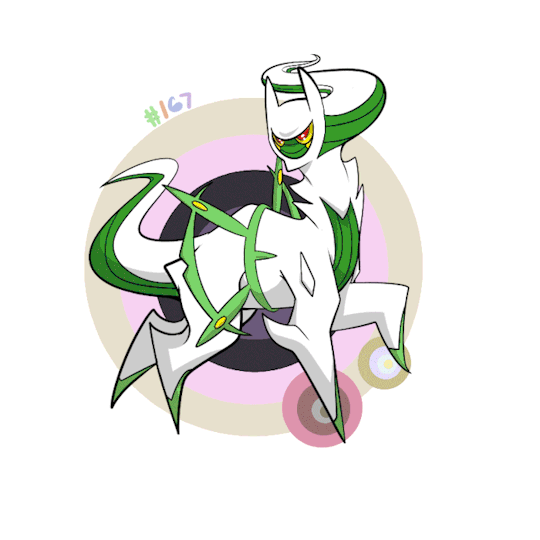
(Ya’ll need to post more Arceus gifs to Tumblr)
And She’s fine with that, because to her, Creation is its own reward.
Boredom as a Warning
Of course, frequent boredom may be a sign of other problems, such as depression or other kinds of mental or situational problems, that in turn might be a sign that outside help is needed. If one of those is or might be the cause of frequent boredom, please find someone that you are comfortable discussing your situation with to get help.
However, in the case where it is not a symptom of a mental health condition or situation where relief from boredom is not under your control, then it might relate to problems in the creative Workspace for yourself.
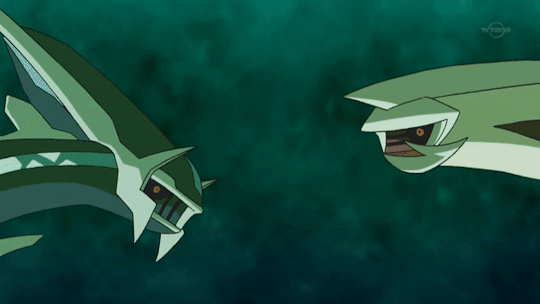
First, think about the time you can spend on Creation in contrast to other things. Time management is important (and the domain of Dialga). Are there times you could use to think of ideas to return to when bored? Are there tasks you don’t really need to do? What eats into the time you do leave aside for such things, if any?
These are all questions to consider when re-evaluating time management as a whole, especially when you feel frequently bored. Perhaps there also might be things to try related to boring tasks that could be related, or a new, more interesting perspective, beyond the boring surface.
Second, consider where you do creative pursuits. Do you have one? Is it mental or physical? Does it feel distinct from when you are doing required tasks, or does it feel like work?
All of these may be a sign your workspace is part of the problem, and I suggest looking at my “The Space of Beginning” series to see what can be done through the example of Palkia to improve a space for a beginning creator.
If neither of these help, the boredom might be a sign that it is time to try something new. This can be stressful, as you may fear losing your skills in what you are already doing, and/or your audience.
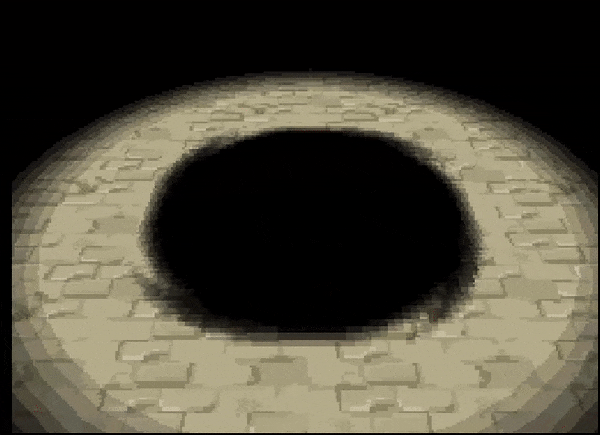
If you can, start thinking about your craft as soon as the joy from it has dulled. Do not quit it on the spot, or take anything too drastic, but examine why it has started to dull, and if there are new techniques or similar crafts to try for variety. These might not be things you end up partaking in, but even so, their purpose is to prevent further “tarnishing” of your current craft.
Sometimes though, this boredom can hit suddenly, or appear sudden as the warnings have been suppressed. Then, you are left to try something new, with no solid knowledge if they will hold your interest, or if you will be able to return to your original craft with the same skills. Even though this is daunting, you should do something new. To continue to suppress the feelings will lead to burnout, which drains a person mentally and physically, and may forever tarnish the thing that burns you out.
In that moment, you must accept that moving away is for your own benefit, and not blame yourself in the moment for ignoring the problems. Try to proceed unclouded, and only when emotions have settled, return to what brought you to that space, and think of how to avoid it.
In Summary
Boredom is more of a force away from itself than apathy or an emotion. While feeling the effects of it can be negative, it is important to pay attention to it, and decipher what it is telling you, to harness its power. Doing so correctly can help your life in ways far beyond simply feeling better in the moment, and may help save a passion of yours from being ruined.
#arceus#giratina#boredom#pokepagan#pokemon paganism#creation trio#acts of creation#not ask#religon#The Desires#dialga#palkia
15 notes
·
View notes
Text
TLOK Episode One a.k.a. Korra immediately goes on a rampage
So, as mentioned, I’m finally getting around to watching The Legend of Korra with all of my terrible tastes and general thoughts.
Don’t give me spoilers, my indignation will be funnier without them.
What I Know About Korra Going In:
If the show can have all of Aang’s bending teachers still around for the audience’s nostalgic pleasure, Suki better be alive and kicking too or I am going to throw a fit
Technology progressed pretty intensely in ways that I will want to pick apart later
Listen, what the fuck is Republic City. Why. Why does this exist. Show you better answer me fast with why this exist for a legitimate in world reason that isn’t just: “The audience is a bunch of American kids and teenagers and we want to uphold the liberal ideals of democracy because of course that’s the motives of the victors after a global war of probably unprecedented scope despite like, Zero (0) indication that the idea of democracy was rattling around anyone’s heads in ATLA.”
If this is the reason, I’m going to quit watching. Disgraceful. Disgusting.
Something involving anti-bender sentiment.
Something involving something called the Red Lotus which I am side-eyeing the shit out of
Bloodbending?????
Spirit World shenanigans and Avatar backstory that’s on thin ice with me.
Love triangles. UGH. TERRIBLE. WHY DOES MEDIA DO THIS. WHO FINDS THIS INTERESTING. PLEASE RAISE YOUR HAND SO YOU CAN EXPLAIN TO ME.
Alright, here we go.
WELL, 30 SECONDS IN AND I GOT MY WISH FOR AN EXPLAINATION ABOUT REPUBLIC CITY.
Avatar Aang and Fire Lord Zuko transformed the Fire Nation colonies into the United Republic of Nations, a society where benders and nonbenders from all over the world could live and thrive together in peace and harmony.
Okay. I’m.... I’m going to withhold judgement for now until I watch like, literally more than 30 seconds to fully form my thoughts about this move. I THINK IT’S A DUMB MOVE AND IF THIS IS WHY PEOPLE KEEP HAVING FIRE NATION DEMOCRACY FICS I QUIT.
So. We get a panning shot into this city. Very urban city that’s the product of the industrialization and like whatever the hell that propaganda voice over is talking about.
As a method of setting the scene and immediately letting the viewers feel and know the passage of time between ATLA and TLOK, I love this shot. There’s no mistaking this for being immediately after ATLA. We’re listening to one of Aang’s kids. There are skyscrapers. The Fire Nation palace in ATLA probably counted towards the architectural development towards urban skyscrapers, but that architecture is fully formed by TLOK. Brilliant.
I'm the Avatar! You gotta deal with it!
What a cute brat. Her poor parents, oh my god.
Also, is she supposed to be a prodigy.
Again with immediately setting contrasts against ATLA. Very cool demonstration, extremely effective distinction between Aang’s journey around the world trying to find teachers and learning how to bend in the middle of a war vs. Korra at peacetime with a whole entire facility dedicated to her.
Not sure about how I feel regarding the White Lotus’s presence.
IS THAT SUPPOSED TO BE KATARA????
That's your grandmother, Meelo.
Does he not visit his parents. It can’t be that hard to swing by for like. Yearly festivals if the Water Tribe has those. I don’t see why not. Maybe something for when the winter night ends, I can see that being festive.
Tenzin do you like. Not call? Not write?? Sir???
Oh my god, Pema. I hope she really likes kids, despite how rowdy they are.
Wait. How old is Tenzin. Thirties to forties?
How old is Katara.
Is this going to be a repeat of the Fire Nation royal miracle babies.
I get that, but I don't think keeping me locked up in this compound like a prisoner is what he had in mind.
Going by the episode title, I bet we know what Korra has in mind. Speaking of this compound, where’s the Southern Tribe? The aerial shots look like it’s in the middle of nowhere. Is she so far removed that she doesn’t even spend time with the tribe she was born into? Cause that sure as hell wasn’t how Aang was raised.
Honestly fascinating as these contrasts keep coming. The bizarre presence of the White Lotus. The way her teachers come to her instead of her seeking her teachers the way Aang and Roku did.
The Avatar must have always been a special political figure, without any good contemporaries to our world, to be honest. Back in ATLA, we see that Roku isn’t beholden to Fire Nation citizenship - he seems to transcend that. And it honestly seems important that Roku and Aang went out to the world, experienced the other nations and their ways of life. I think Aang does have a line regarding this.
Because Korra’s situation? Can easily turn into a nightmare, given the realities of what being the Avatar could easily mean.
OKAY THIS SHIP. Very cool looking, very neat, I continue to love every visual manifestation of the passage of time between ATLA and TLOK. One small question. What’s with the rigging poles.

(source)
To be fair, this is a battleship from the British navy, but aesthetically I think we can say this is a fair inspiration. From what I remember while researching the coal fic, the rigging and poles there serve no function. It’s aesthetical. At best, there’s a limited function, but it’s predominantly for aesthetics in the transition into the ships like the Titanic with no rigging at all.
Which raises my question about WHY ON EARTH?? The Fire Nation navy in ATLA??? Were clearly way past this stage in design? Literally during Sozin’s time too??? Almost two hundred years before this current shot in TLOK? Why would the ship design regress like this??? The Water Tribe ships probably wouldn’t evolve into the designs that Europe used? Earth Kingdom ships would probably be more inspired by East Asian designs which also wouldn’t end up with this system for sails?
Where does this aesthetic come from.
IS THAT A CAR.
....
.......
..........
I am not qualified at all for dissecting the potential social and cultural explanation for the western influenced aesthetics appearing. I am but an ignorant banana, I don’t know shit.
.......
oooooooh this is going to slowly annoy me isn’t it..........
That will be twenty yuans.
[Jaws theme]
The city's huge. I bet we could find a place to rustle up something to eat.
You know, I’ve seen plenty of weird shit in Central Park and around NYC before. Korra, you are so unprepared.
Are you tired of living under the tyranny of benders? Then join the Equalists!
Oh boy. Let’s.... let’s put a pin in this thought. I’ll come back to it once I know more about what’s going on. Because. This will either be fun. Or I’m going to have to create a second spite fic folder. Please, show, don’t give me reason to create a second spite fic folder.
On a different note though, I really do love the choices so far for setting up this show’s forward path. There’s no way to mistake this as a rerun of ATLA. This is it’s own separate story and I love that. I really do respect that. The way the different threads are emerging feel really smooth: 1) the impact of Korra’s isolation towards her culture shock in the giant city - which must smell and sound REALLY weird to her; 2) her prodigious talent in the physical, exciting parts of bending meshing with her teenage nature and also clashing with the spiritual parts of being the World Bridge; 3) the absolute hot bed of chaos every part of Republic City must be.
Kinda funny that people would still have sideburns in the same style as from like. Seventy years ago. Vintage.
Mr. Chung, please tell me that you have my money, or else I can't guarantee I can protect your fine establishment.
My terrible taste in interests rears its head again. Listen, you cannot imply something like the mafia or the triads exist in universe and not have me immediately ALL OVER THAT. Republic City, you are such a mess. Like, for this alone, I might write a single fic for TLOK that’s just about trash collection and disposal. And corruption. And-
I am fascinated by the genetics and molecular/cellular biology behind the yellow and white eyes in this universe.
Police! Freeze where you are!
Bitch what the fuck. How many of these rigid airships are part of the police. Are all of them for the police? Are the police literally patrolling people from the sky?
Also, that better be helium in those ships instead of hydrogen by this point in time. I’ve already made my post about the fleet of hydrogen ships in Sozin’s Comet.
How much property damage is being inflicted thanks to these couple minutes. The police just. Stab the brick work. There have got to be so many bitchy lawsuits about that.
This poor girl’s culture shock.
HEY I HOPE THAT POLICE OFFICER SWUNG THEMSELF ON A CLOTHLINE, NOT AN ELECTRIC LINE LIKE I FIRST THOUGHT.
HEY YOU CAN RIP SOMEONE’S SCALP OFF LIKE THAT.
HEY WHAT IS WITH THIS WHOLE SCENE.
HOW ARE THEY JUST RIDING ON THOSE WIRES, HOW MUCH TENSION IS IN THAT STUFF.
HOW DOES THAT ZEPPLIN MOVE THAT FAST AND LIKE. AGILE.
YALL.
WHY DOES THE POLICE STATION LOOK LIKE THAT
Well then, why are you treating me like a criminal? Avatar Aang and your mother were friends. They saved the world together.
Oh this bit is fascinating, I love it. It’s only been 18 minutes, but the level of sheer propaganda everywhere trailing after Aang is really cool. There’s so much I want to know now about how Aang got from the end of ATLA, where he probably wasn’t thinking AT ALL about this kind of cult legacy forming around him, to this.
Lin Beifong’s shut down of Korra’s attempt to use her status as Avatar is great. Just because Korra’s born into this elite role and then locked up and probably pampered in her compound, where everyone is well aware of her status and what it means, it doesn’t mean she gets to strut around with no idea how stuff works or the context behind what she’s seeing and then doing whatever she wants.
Contrasts, love ‘em.
On a different note, the design of this room.
As far as I can tell, it’s a dim, doorless room, which is honestly. Really terrible design. And it says something about the way the Republic City police functions and how that reflects on the chaos of the city itself.
Putting someone dragged into the police station in a dim room without any door as a sign of a possible escape is just a terrible idea. The only thing you’re going to succeed in is making the person tenser and more belligerent. Your suspect or witness gets more nervous, gets more combative, gets more unreliable in this kind of environment. In turn, the police probably starts feeling more and more entitled to harsher retaliation. Conflict resolution? De-escalation? That really doesn’t look like its in the core of the city police. They’re wearing armor for god’s sake.
Everything so far in this first impression of the police is really damning about their attitude and Lin Beifong’s leadership. Rather than using a rappel line down from the airships, they damage buildings. In chasing Korra, they further damage property. The armor, this freaking room. The fact that so much about the active police shown so far depends on metalbending, which implies that very few people can join the field police. The fact that for the gang to be so blatantly in the open about their presence and territory, there must be dirty cops on their payroll.
There has to be so much Lin Beifong hate in this city.
I have done my best to guide Republic City toward the dream my father had for it, but you're right. It has fallen out of balance since he passed.
If anyone tries convincing me Republic City was ever in “balance” they’re a punk ass liar. I don’t think the city could have ever been in balance, whatever that is. The way it was created, the speed it expanded, the life that must be lived there - balance? Don’t kid me with that propaganda.
Tenzin could be trying to find a balance alright. I just wonder how many people vehemently disagree with his idea of balance.
Hello? I'm Korra, your new Avatar.
Well, TLOK is definitely in the era of mass distribution of news and the idea of public sentiment at a level never seen before. This is going to be very interesting for its populist implications, along with other developments regarding politics.
Oh Korra. Did no one try rehearsing this with you? This is a terrible first impression for you to give to people.
Also, what is this building. Is this like a city hall? Why is the roof on the building to the side slanted like that. That’s an angle I’d expect from like. Snow concerns. In northern Europe.
Love that Avatar Aang propaganda. Starting to feel like we’re going to see a lot of it going forward.
Oh my god, everything about this press briefing (?) is highly concerning. This rampaging teenager suddenly appearing without any warning or announcement. The clear lack of script or practice. The open location just to anyone instead of to a select set of journalists who would be sympathetic/under government control. Lin fucking Beifong and Tenzin being the only people accompanying Korra on the stage.
What a disaster.
FINAL THOUGHTS
You know, I’m enjoying this more than I expected to. The general writing is great, the use of visuals and other small details to set the time and place is excellent, the worldbuilding implications are rich in potential. I’m looking forward to exploring where the plot threads introduced so far will lead towards!
#the legend of korra#navi watches lok#these are each going to get pretty long#i'm a really annoying person to watch stuff with#i'm half seeing half SUPER not seeing why the fandom likes lin beifong so much#republic city makes me miss living in manhattan though
7 notes
·
View notes
Text
Method of Loci and Reality Shifting
There was a video from a source that I will not name that brought this community to my attention. Thus, if you will allow me to do so, I am going to give my two-cents on the matter. Let us see how this goes.
In terms of reality shifting itself, I do not think that it is a real phenomena, at least in the way that it is presented in terms of literally going to another universe. However, I know that this would not go over well, so instead of contesting the whole of reality shifting and getting chewed-out by everyone, I am going to instead compare it to something that I think is more realistic: Memory Palaces. Reality shifting, really, may be understood as a form of creating spontaneous memory palaces, like in dreams with space (not outer space but more along the lines of “distance”) in them.
Assuming that most of you reading this are children or young adults, I do not necessarily want to be responsible for getting you into memory palaces, or more properly the Method of Loci. To be honest I only know about such a method from the title of Frances Yates’ book on the subject, which I learned about from studying Giordano Bruno. Indeed there is another post on my account about him that may be of interest.
Without attempting to invalidate anyone aside from the second paragraph, as that is not my intention at all, okay, I would like to delve into a brief summary of memory palaces, and how they contrast with reality shifting. Then I will seek an integration of the two.
If I am to be frank, my intention with this post is to help to transform Dark Academia into the next Renaissance, in accordance with the theory of a certain YouTuber. I have come to the conclusion that in order to make this work, the “aesthetic” element of Dark Academia will need to be replaced with actually finding and reading great texts from around the world. Here’s to hoping that can happen with this discussion of the Method of Loci or Memory Palaces augmenting the practice of Reality Shifting. Food for thought; cheers, and lets get down to the meat of this essay.
* * *
Memory palaces function with two essential elements: The space of the building or location where the perception takes place, and then the mnemonic devices intended to enable memorizing things. You could potentially build a memory palace in Minecraft if visualization is difficult for you, but that is a bit off topic. Cicero the Roman Senator and rhetorician came up with the method in the first place, and Giordano Bruno wrote many books on the subject. The specific division of the elements of a memory palace in my own take, admittedly I do not know too much about any of this, but I was hoping to make this post anyway and see what someone could make of it.
Spatial memory is obviously going to be important with regards to designing and using a memory palace. An author that I will not mention... Well actually he was the guy who wrote Maps of Meaning, but I am not in agreement with absolutely everything that he says. For instance, his protest of the use of gender pronouns in the name of freedom of speech was quite silly, and in fact invalidating for the transgender community, and I do not condone that. At the same time, I do not buy into the other idea that all of his work is utter gibberish, a stance that some people stand by. His work is a mixed bag. I contrasted the titular maps of meaning with memory palaces, and it seems that they both fundamentally rely on differences between values, and spatial memory respectively. Hypothetically both latter terms generally feel to me like they are the same.
As for the design of the memory palace itself, why, it can be any location that you wish; fictional, natural or real. The problem is knowing the architecture of the fictional place, as I know that people on here are really into fandoms and that is inevitable. A historical-mythical anecdote is the Temple of Solomon and the fascination that Europeans such as Isaac Newton had with its layout as described in the Old Testament of the Bible. Idk, but at least we have those cross section books now, so it should be much easier. Either that or you can design it yourself in your mind, on paper, in Minecraft or using Lego Digital Designer. Yes, that software is still my favorite Lego CAD (computer aided design) despite having not used it in years.
In terms of icons that populate the memory palace, they could be construed as NPCs or something that you could potentially generate by listing out human emotions, and more importantly how people express them. There is a field called Kinesics (not kinesthetics as I almost typed) and this deals with body motion and expression, but keep in mind that this is advanced college-level stuff. It could be used to image various body movements for these NPCs and enable a very vivid experience. Again, although I want to spur interest in the transformation of the Dark Academia community into a Lay Renaissance; the method of accomplishing this is to “ditch the aesthetic,” a tag I have appended to this post, and start reading classic texts, at the same time I do not want to be responsible for a bunch of teenagers and children getting into subjects that are either occult related, or too dense for them to understand properly. (I think I’ll make another post about the “ditch the aesthetic” movement eventually.) This distinction is of great importance to me, and I hope that whoever is reading this can appreciate that.
I do not know the intricacies of reality shifting, so I will not talk about that today. You probably know much more that I do about it, and although I do not entirely agree, I can respect what you believe.
The last thing that I have to say, or, two things, is that if you accentuate your the things you want to remember with strong emotion, then those things will be more conducive to be remembered. The same thing applies to memory palaces and reality shifting. This advice was stated by Giordano Bruno himself in one of his books, which name I unfortunately can’t recall.
Lastly, if the whole reality shifting thing gets too intense for you, I’d recommend just leaving the community, or more realistically just sitting on the sidelines and taking in some of the positivity emitted from the community, as I have seen some of the posts on here and they look like they do that. I don’t want to stir up any controversy, but if you have constructive criticism I would love to hear it in the comments. I don’t personally think that disagreement needs to be angry, as that just isn’t really feasible in terms of the proper functioning of society. Conversation and the exchange of ideas is better than being angry, and I hope that I have been civil enough in writing this. Sorry that this whole essay was so long in the first place; if you read all of this, I commend you.
6 notes
·
View notes
Text
@redratrobed Sent: 🍓 and for me say what I love about their blog! (Accepting)



EARTH DAD!!! YOU WANNA HEAR ME SEND LOVE FOR YOUR GENTLE BOI?! WELL HERE YA GO!
Kravitz, you are truly one of the most creative rpers I have ever gotten the pleasure of writing with, and writing Kravitz Land with you, Steph, and Vosh has truly been one of the most unique and fun rp experiences I have ever been apart of and I’m so thankful for it. Your ability to take a canon character and truly make them your own with added lore, distinct character choices that come as a result of character development, and how they truly are never the same as they change with each interaction is such a gift and I hope you know that! Being able to do that is no easy feat!
Having the chance to see your doggo boy go from rough and tough Inuyasha to gentle and heroic Sora has been truly incredible to see, and I’m so happy me and my muses have gotten to be apart of journey! Whenever I see Inuyasha with black hair, your boy instantly comes to mind, that’s how distinct you’ve made your muse! The same also goes for former mystery man Asahi, who you know I also love and cherish even as he continues to break Hana’s heart. (Thanks Des...).
Your writing is always crisp, clean, and potent. It’s really easy to follow along and get sucked in with everything despite how complex of a story we all going on, especially seen in your mor novel/drabble posts. I especially how how you portray character’s dialogue, and the contrast between Sora and Asahi can truly something that can be seen just through that alone. I also love how your tags are, the way your blog is set up like visual novel routes, and how you always find such pretty and nice ways to make new icons! I love seeing what you come up with!
In short, you know I love ya Kravitz. You have managed to create an engaging storyline building off what all of us have done and do it so well. You give your characters depth in a truly special way, and I hope you never doubt yourself because you are seriously incredibly talented. You def have inspired me in several ways, especially on embracing what signature aspects I’ve added to my muses such as Kagome’s cherry blossom and pink aesthetic.
You have a wonderful day today, okay?! Love ya! <3

#redratrobed#💎 Late Night Gang's Mastermind (Kravitz)#💎 Dottr Treasure (Mun)#💎 Dottr Answers (Mun Asks)#(FOR EARTH DAD <3
3 notes
·
View notes
Text
Why The Prince of Egypt is fuckin amazing
Literally every second of the opening
Ramses and Moses being 10/10 sibling representations making dumbass decisions and almost getting each other killed
The swell of music when Pharoh says the "weak link" line
Moses whistling his mother's lullaby
The the way their voices echo when Miriam and Aaron meet Moses
The music. All of it.
THE DREAM SEQUENCE, HOLY SHIT
Moses horror when he sees the mural
The base and rising dissonance with the line "they were only slaves"
Tuya isn't villianized and very clearly loves Moses as her son and this part makes me emotional okay!
Moses becoming incapable of ignoring the pain of the hebrews anymore
I think if every biblical story were told as beautifully as this movie, I'd still be catholic, goddamnit this movies fantastic
The frantic way Moses removes all his regalia except Rameses ring
The girls trying to pull Moses out of the well
The smug look when Tzipporah drops him back down
The music. Again.
This Is My Home playing as Moses looks over the sheep and his new life
The animation of the burning bush
The voice of God perfectly encapsulates the whole fear/reverence feeling
Fuck me this whole scene is thrilling
Also I had a weird fixation as a kid on the detail that Moses had to remove his sandals while standing on holy ground. This doesnt add anything major to the movie, I just like this scene a whole lot
THE WAY THE PEBBLES ROLL AWAY FROM THE BUSH
THE WHISPERS UNDRLAYING GODS VOICE
FUCKING HELL, THIS SCENE IS SO GOOD AND FULL OF TERROR AND WONDER AND ITS SO BEAUTIFUL AND I LOVE IT
I grew up with this story, and it is just such a perfect representation of how these stories SHOULD make you feel. Obviously this is rarely the case, but this movie does it so perfectly.
The bitter sweetness of Rameses' and Moses' reunion
Look, we all know I'm a sucker for theatrics. I was OBSESSED with the scene where Hotep and Huy conjure the snakes
Moses' snake eating the other two
MOSES RETURNING RAMESES' RING
Moses' humility pretty much throughout the movie
The way the female characters are all drawn with distinct faces and bodies
I really like the water animation, it's so pretty!
ALSO THE WAY THE BLOOD SPREADS IN THE WATER IS REALLY COOL AND DISTURBING
The "blood" Hotep and Huy create not having the same look as the real blood in the river
THE PLAGUES. HOLY FUCK THE PLAGUES. THE SCENE, THE MUSIC, THE HORROR, THE BIBLICAL ACCURACY
The conversation before the last plague between Rameses and Moses. Everything between them is so well written and believable
The last plague. It's a horrifying scene, but not in the same way as all the others. It's a quiet, ominous, haunting terror, and the lack of music is brilliant.
I love the visualization of the angel of death. Although I think it wouldve been cool to have the traditional many eyed and winged horror, the contrast of the wisps of white air carrying the last breaths of all the first borns against the stark darkness is...intense
The rising wailing and agonized screams as the sun begins to rise and as the only sound as Rameses covers his son with the sheet.
Fucking hell this movie gets really intense sometimes
Moses own horror at what has happened and how he sinks to the ground weeping
The rising light, music, and hope as Miriam begins singing
The few soldiers who join the hebrews as they leave egypt
The singing in hebrew
THE COLUMN OF FIRE, WHICH IS ACTUALLY A THING IN THE BIBLICAL STORY AND NOT JUST A BADASS DETAIL IN THE MOVIE
THE PARTING OF THE RED SEA IS FUCKING GLORIOUS AND BEAUTIFUL AND EVERYTHING IT SHOULD BE
THE ANIMALS ILLUMINATED IN THE WATER, FUCKING HELL THIS MOVIE IS BEAUTIFUL
THE WATER RUSHING BACK IN WITH ALL ITS FUCKING MIGHT
the mix of awe and shock on the peoples faces as they look out at the sea, safely on the other shore
MOSES CARRYING THE TABLETS DOWN THE MOUNTAIN AS DELIVER US RISES TRIUMPHANTLY even though the movie ends before he gets to the bottom and learns the hebrews started worshipping a golden calf in his absence, but we're not gonna worry about that
90 notes
·
View notes